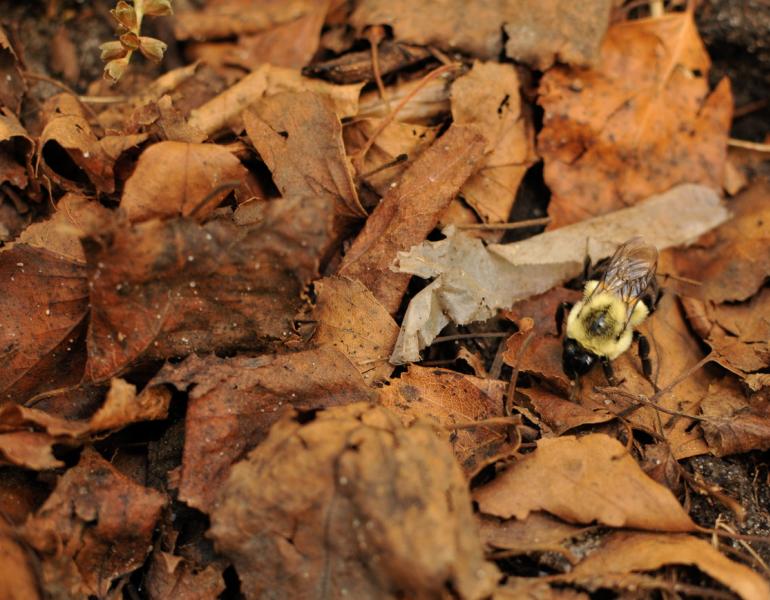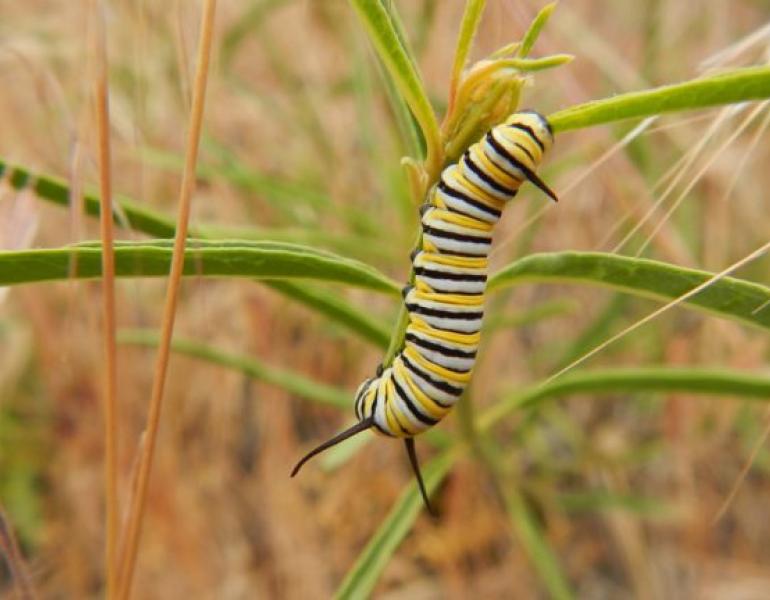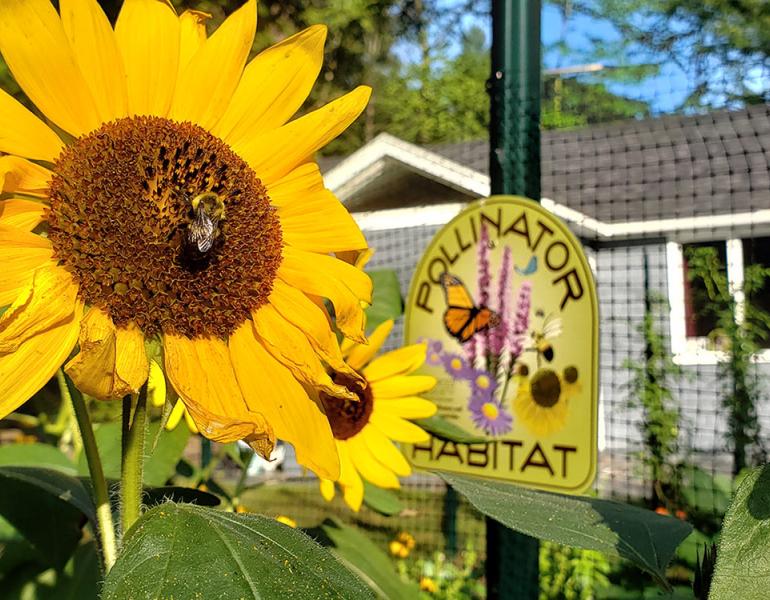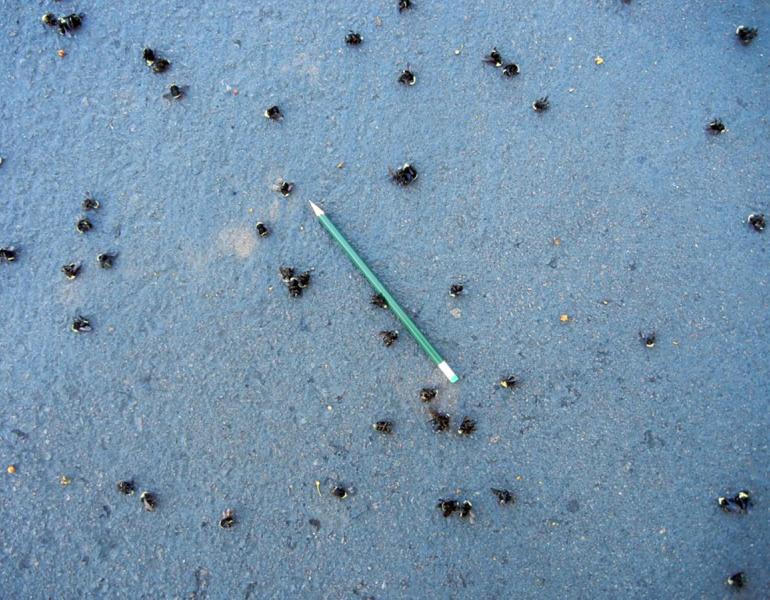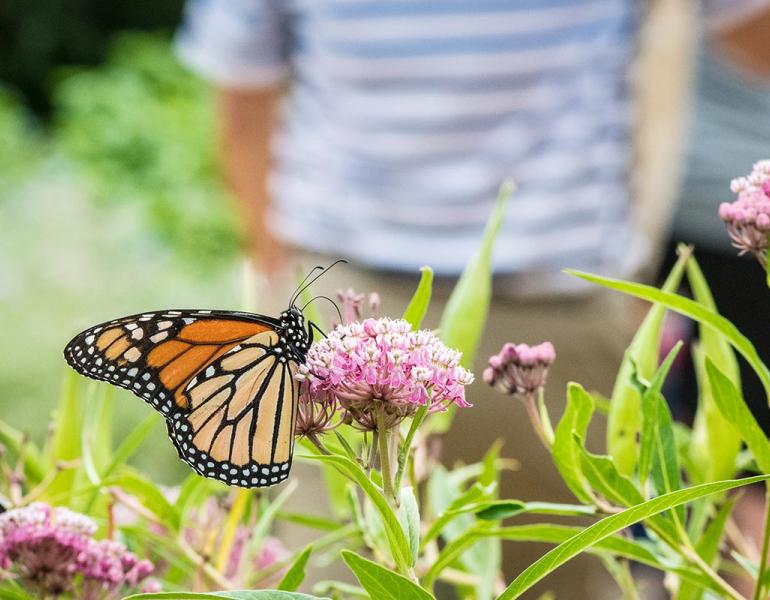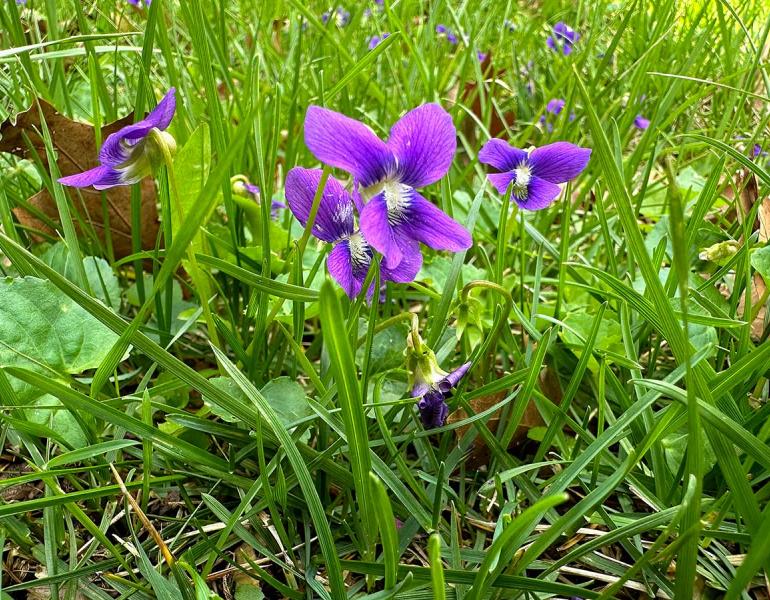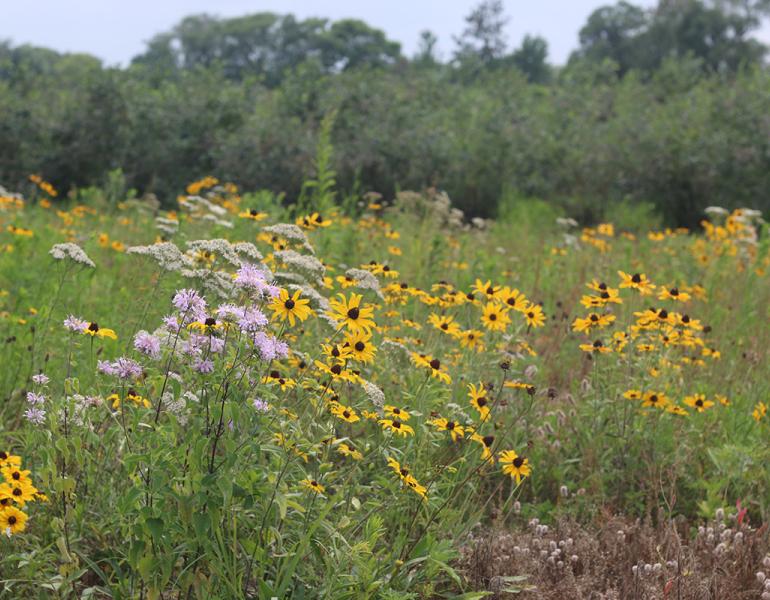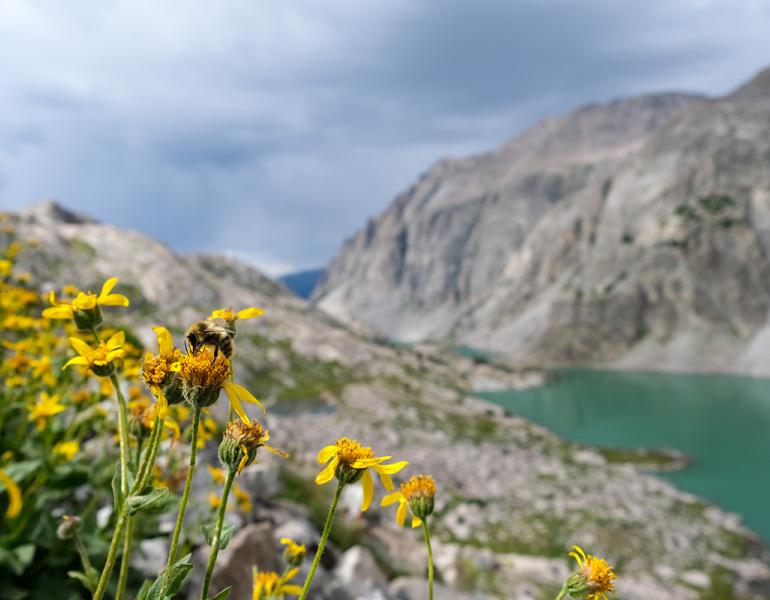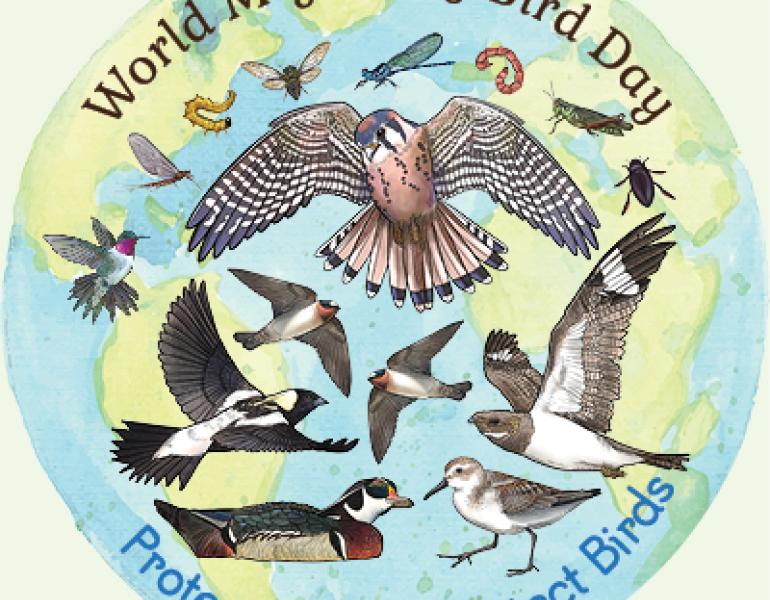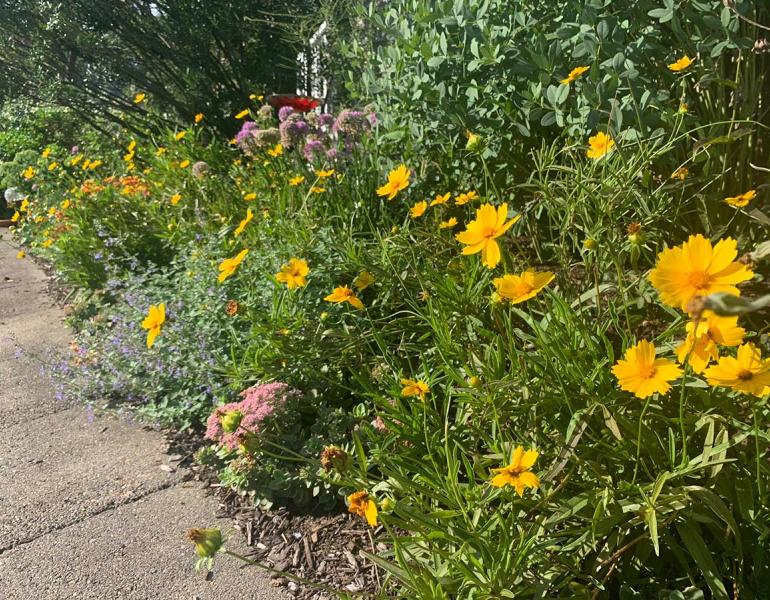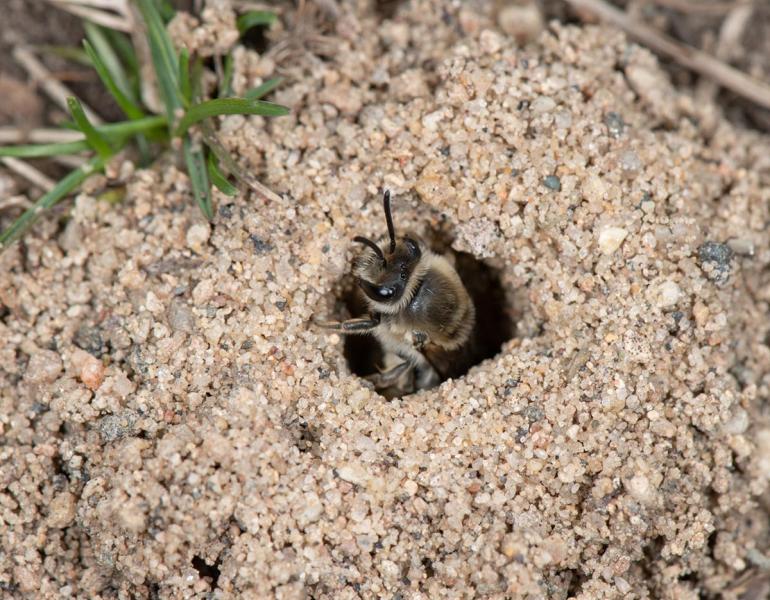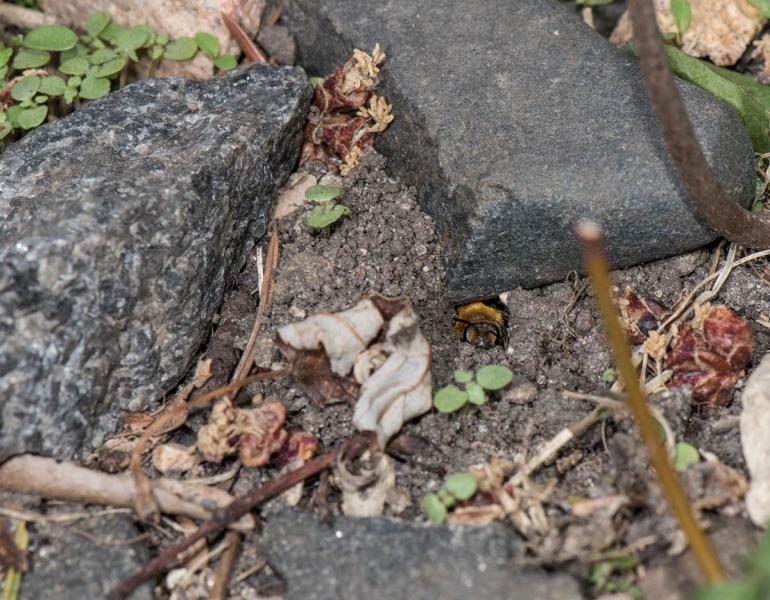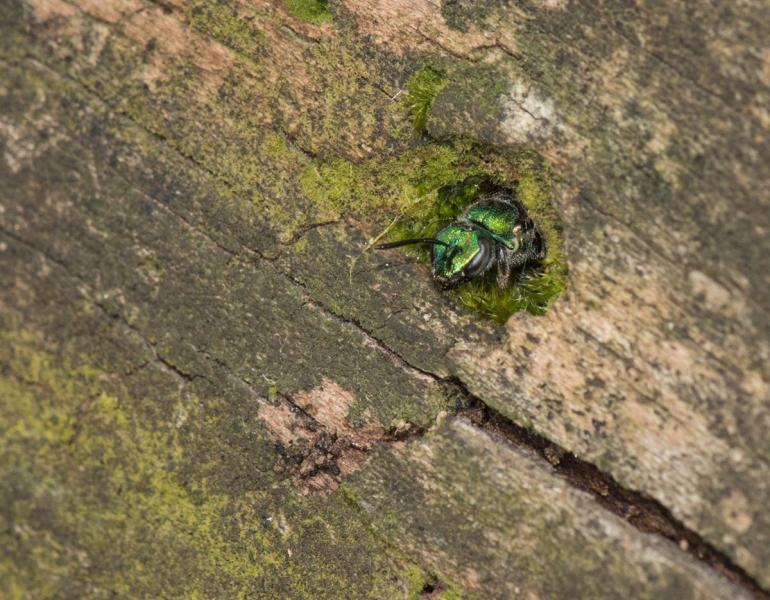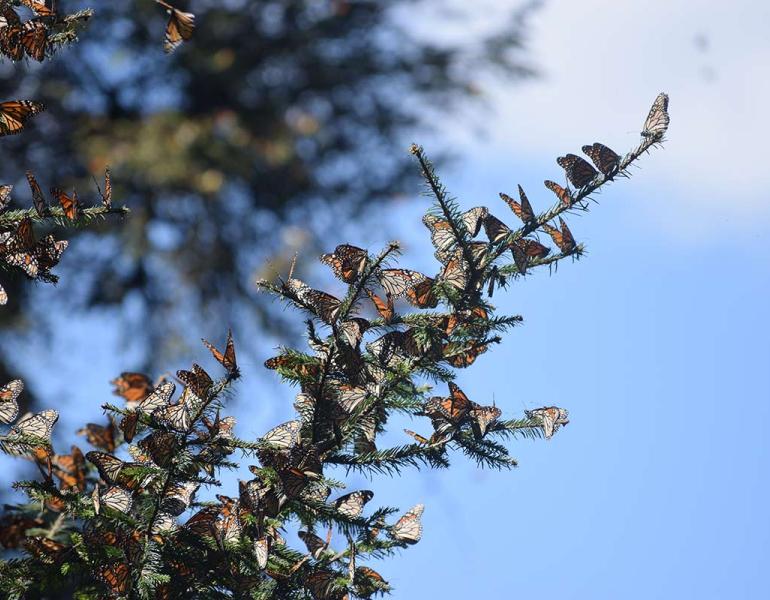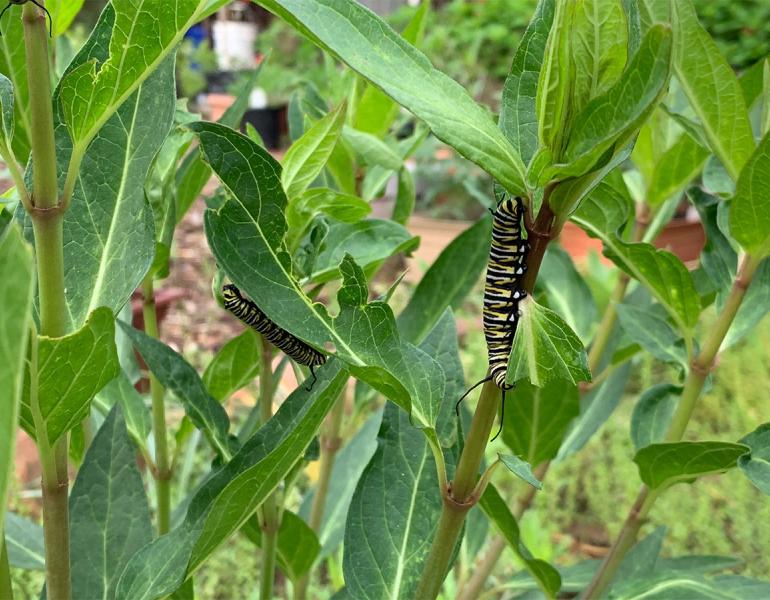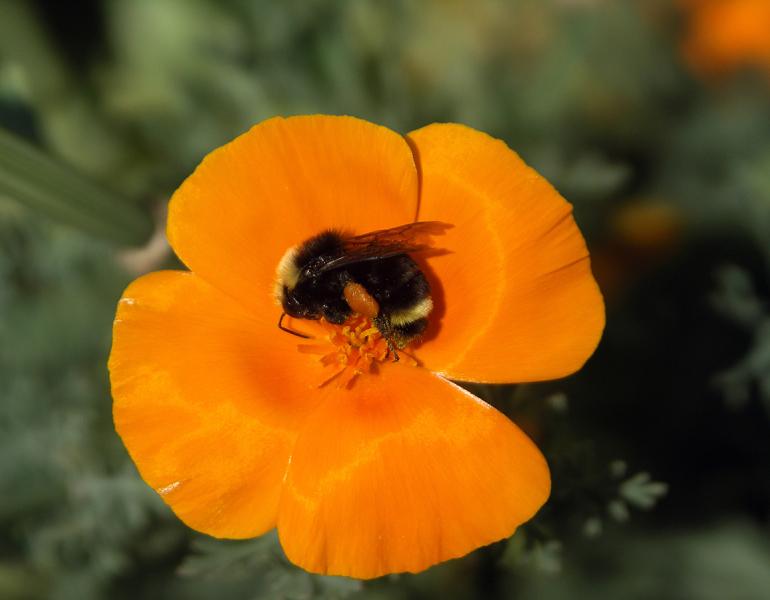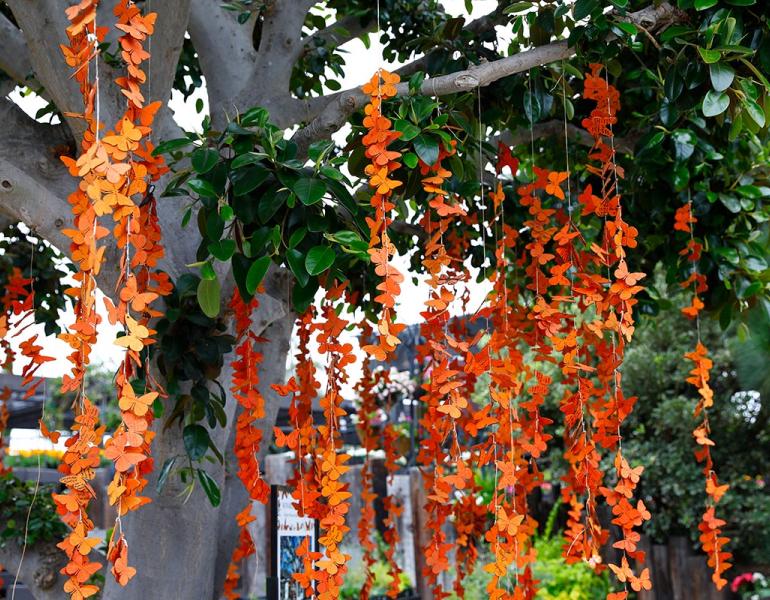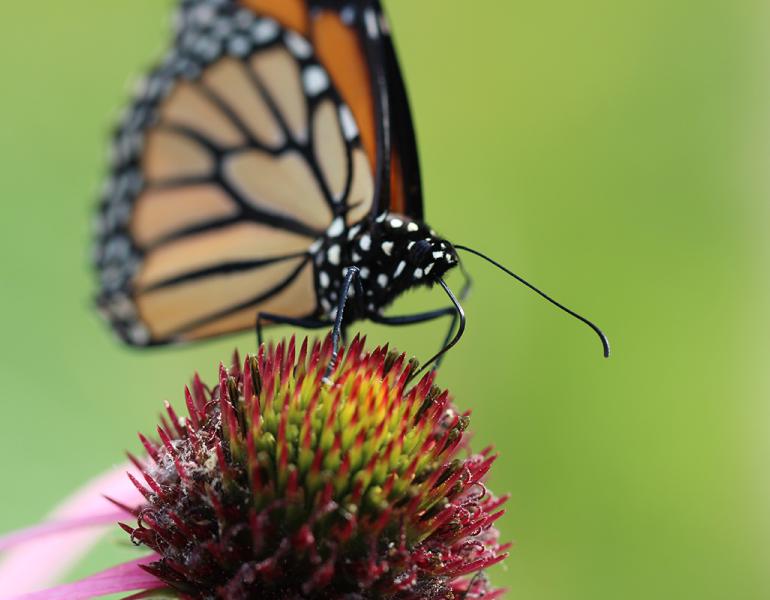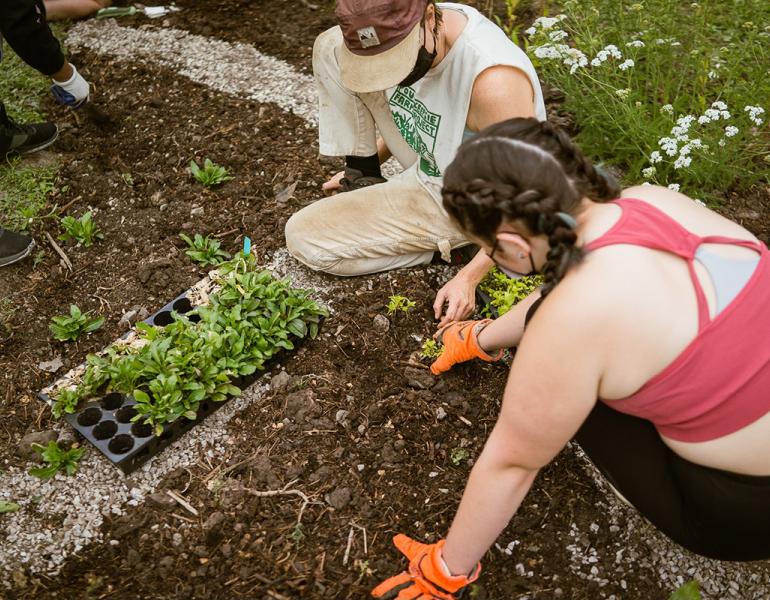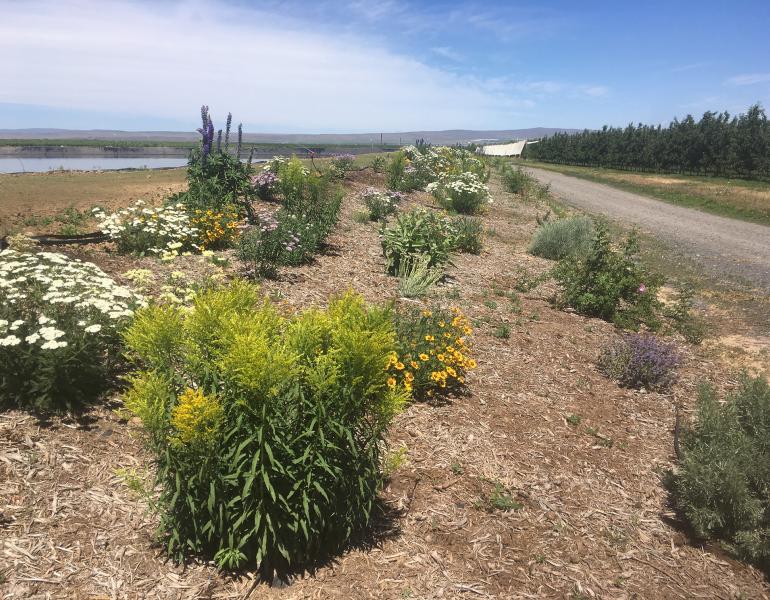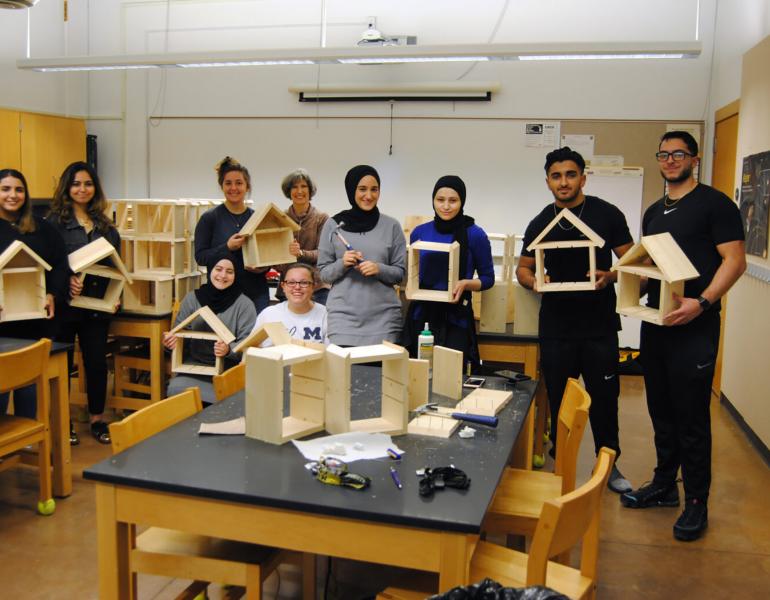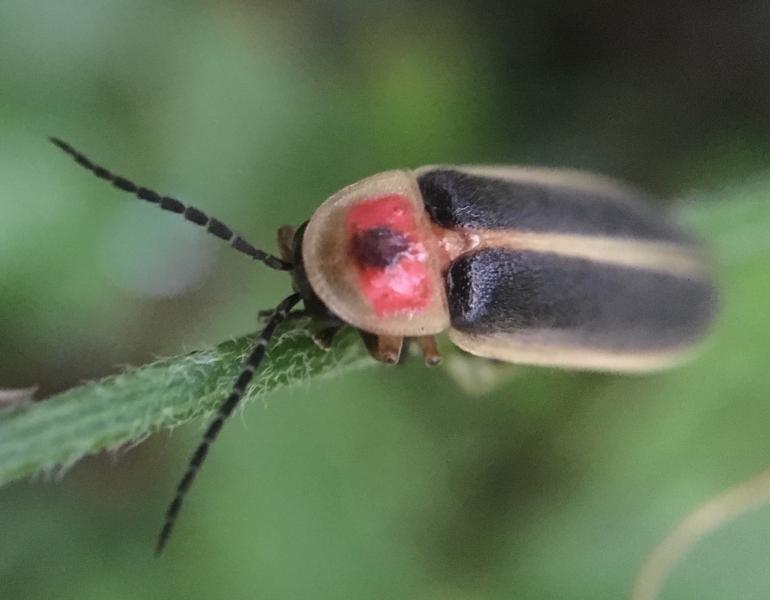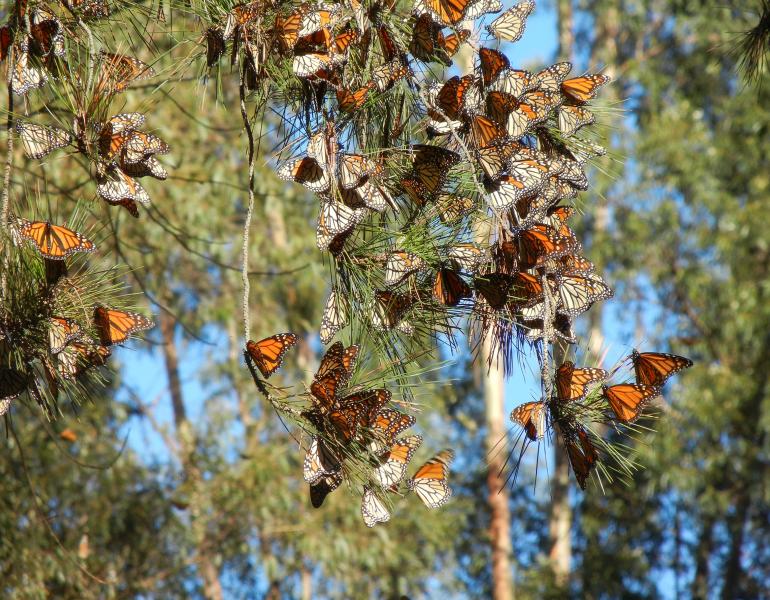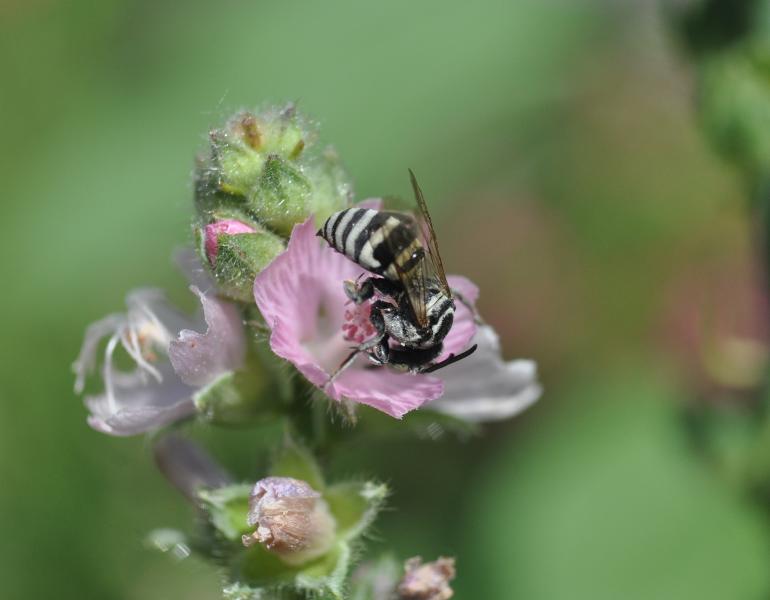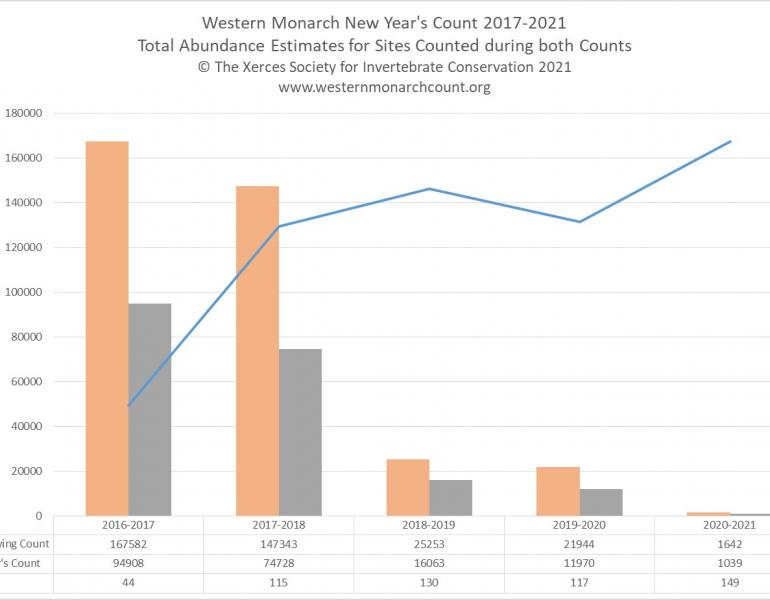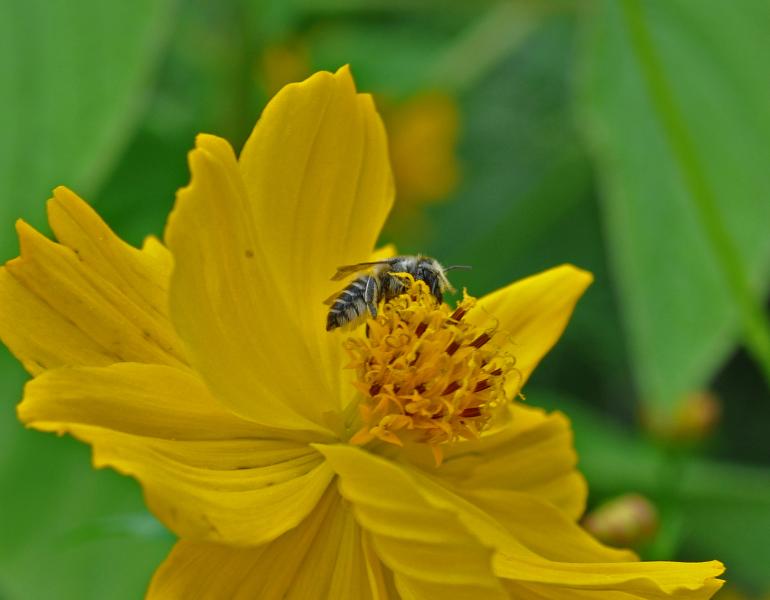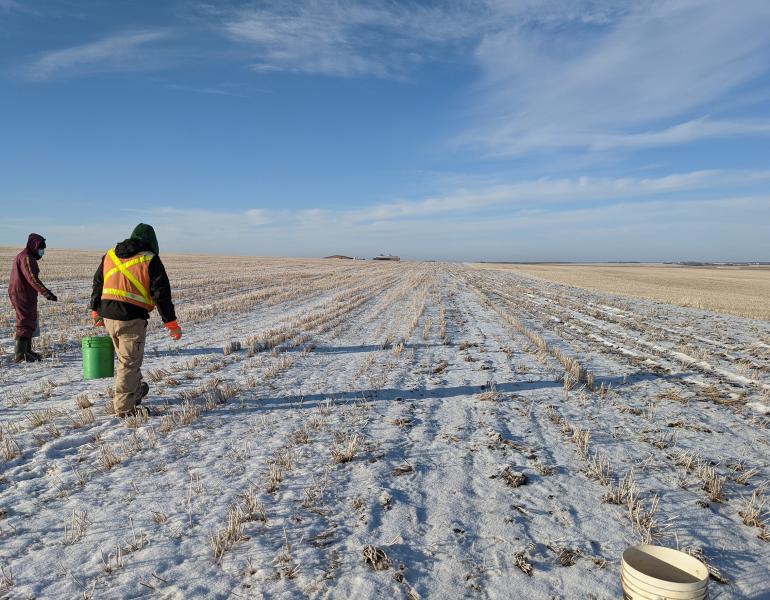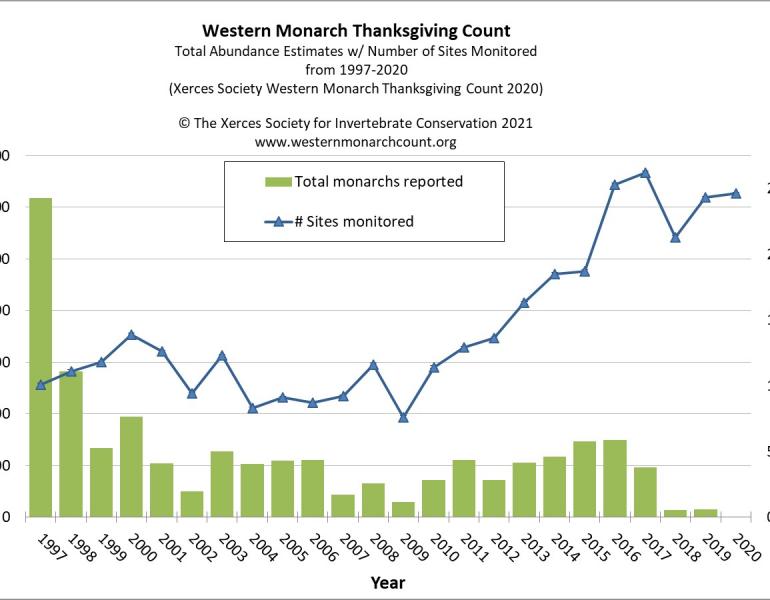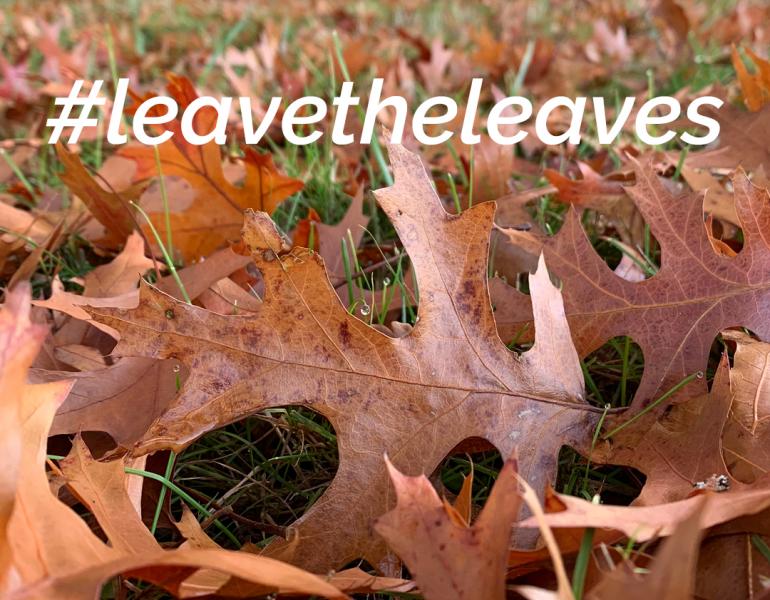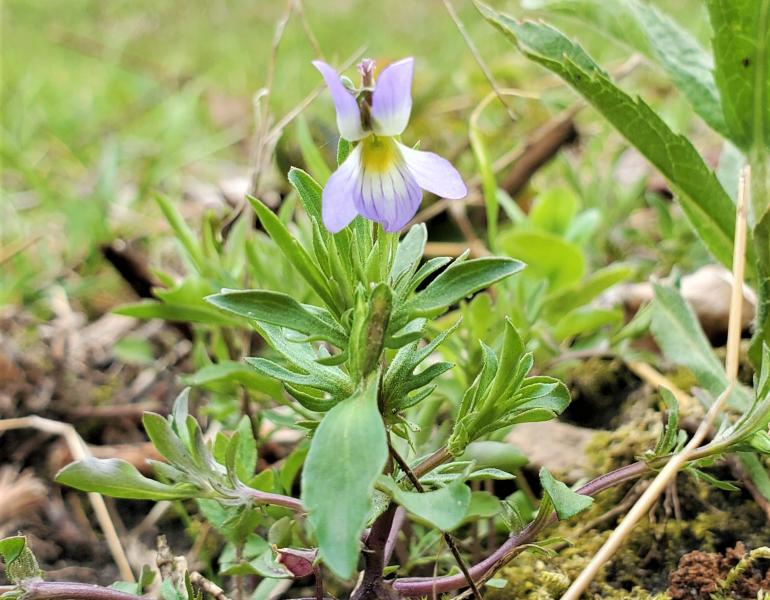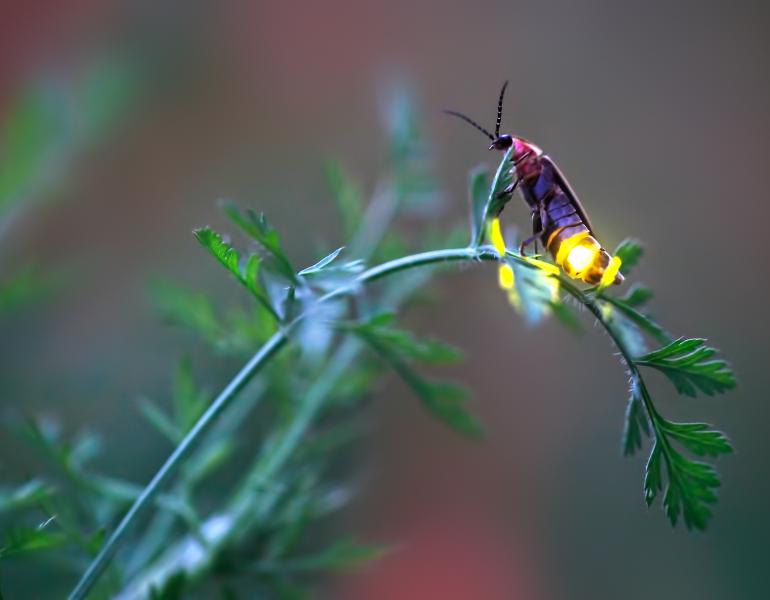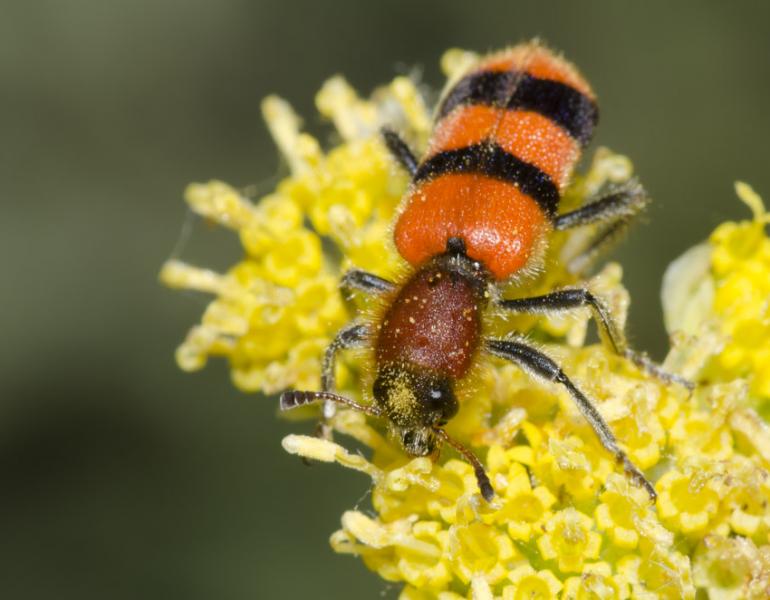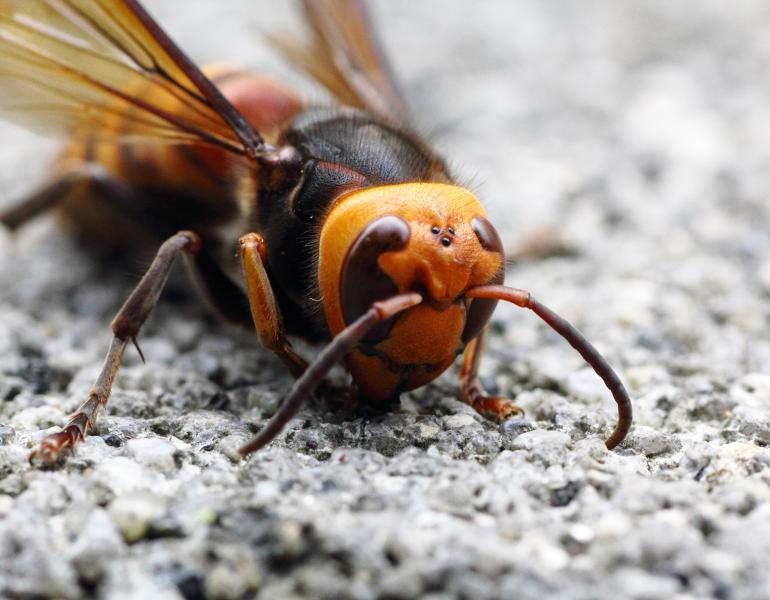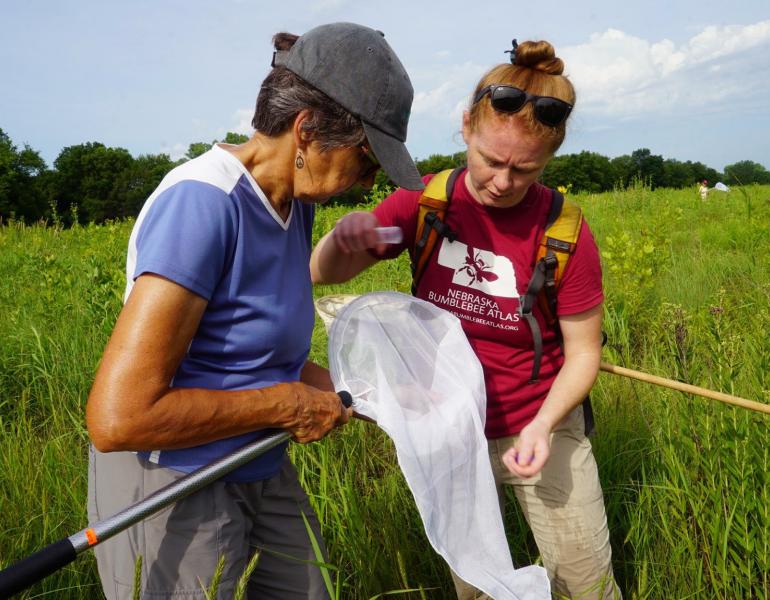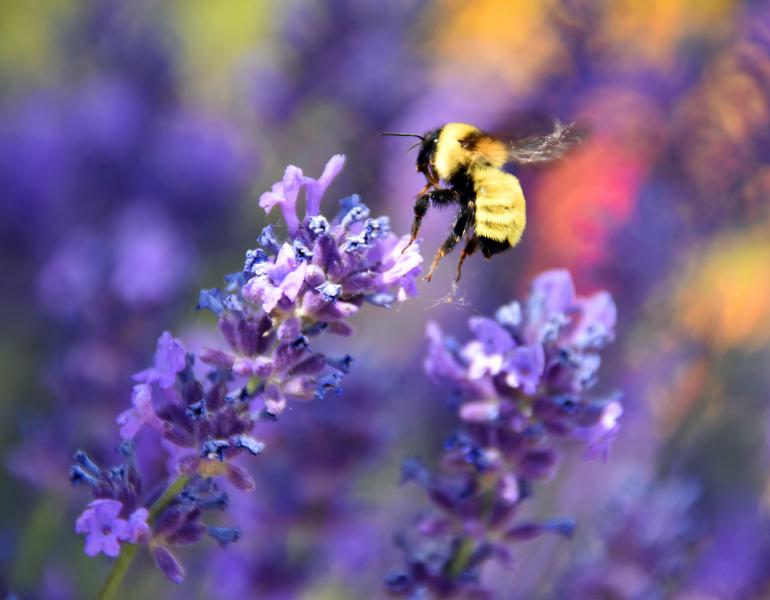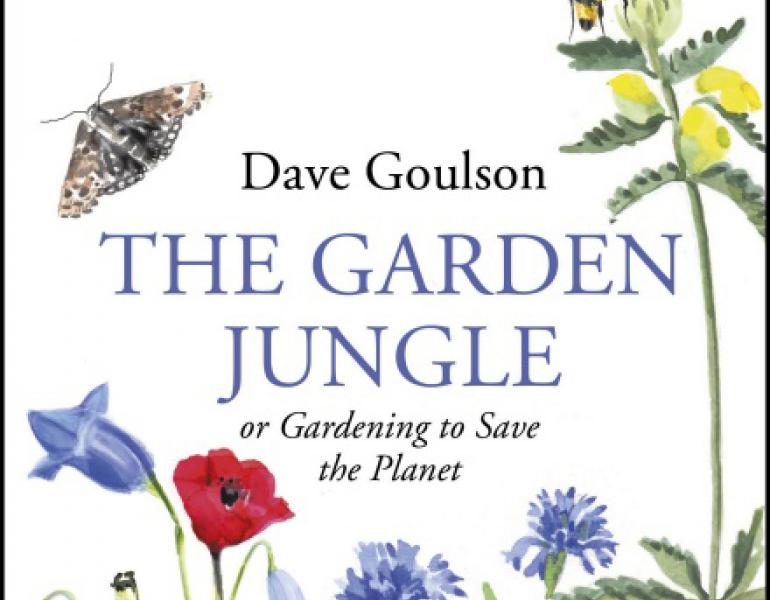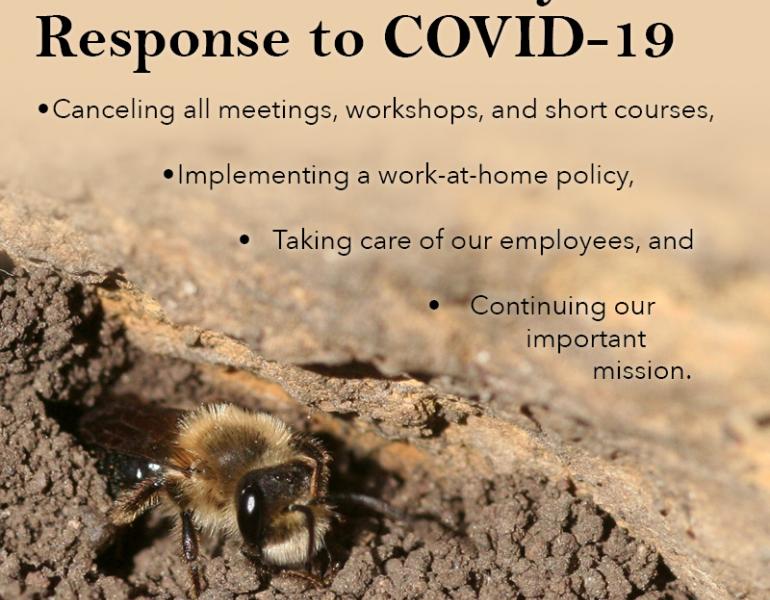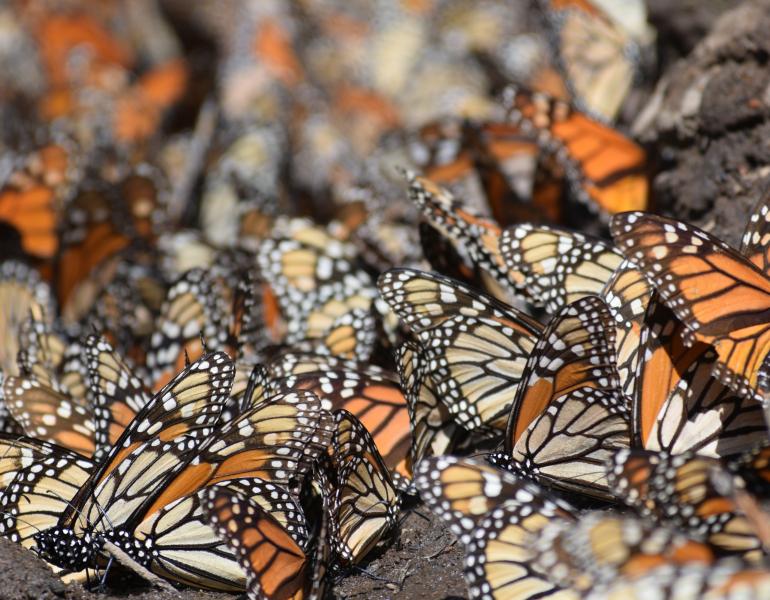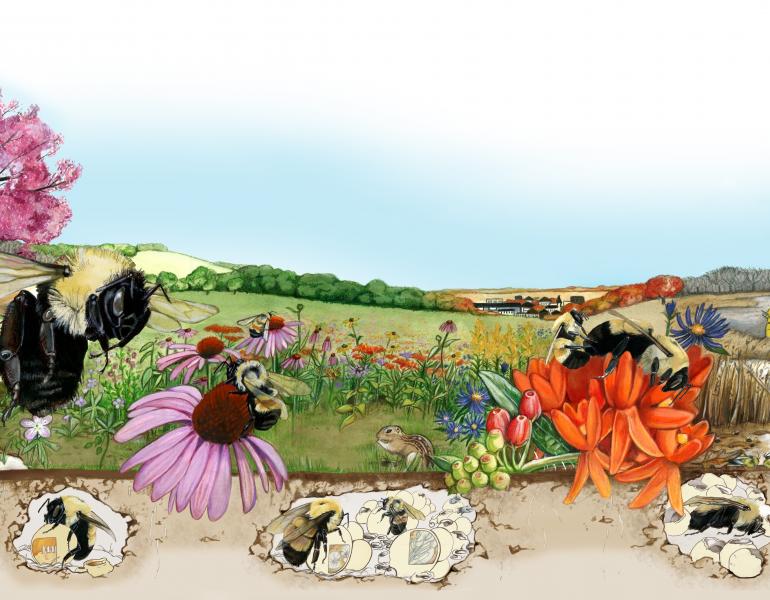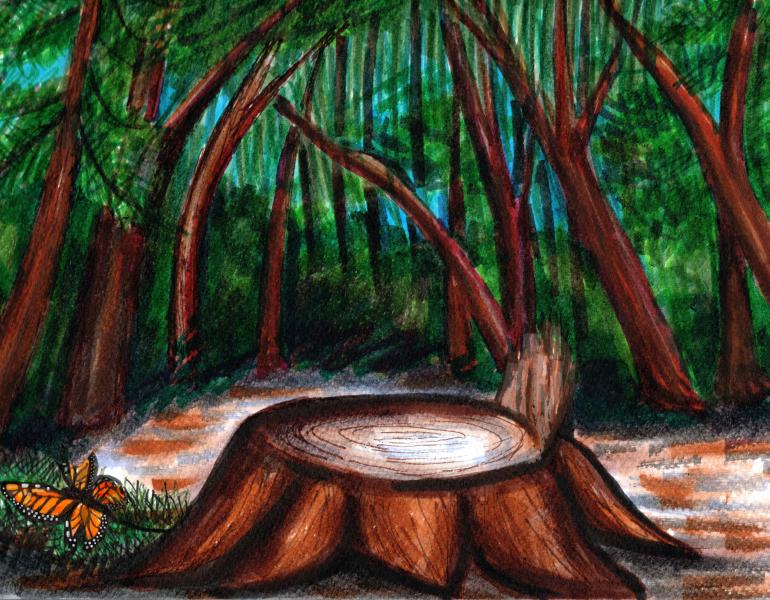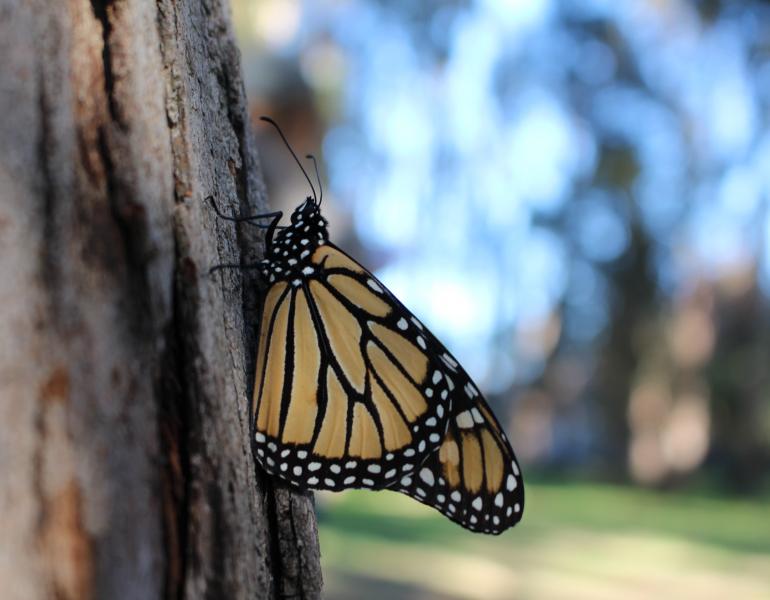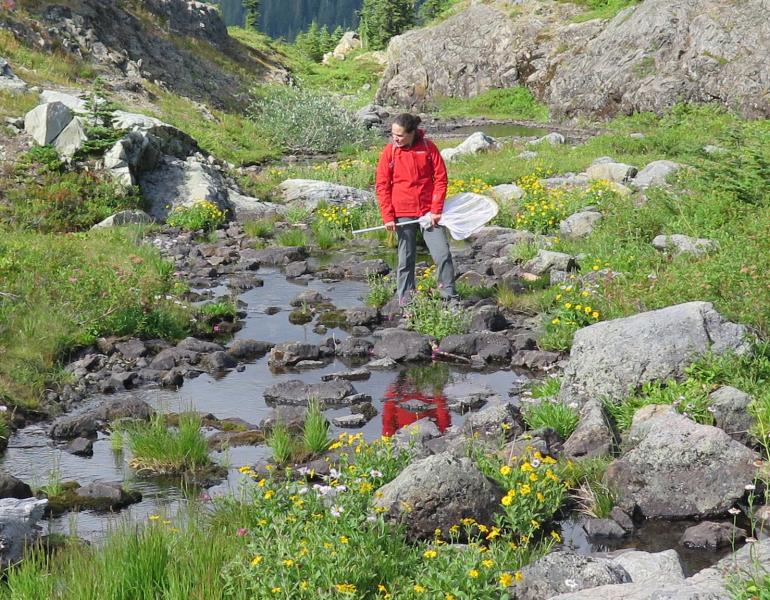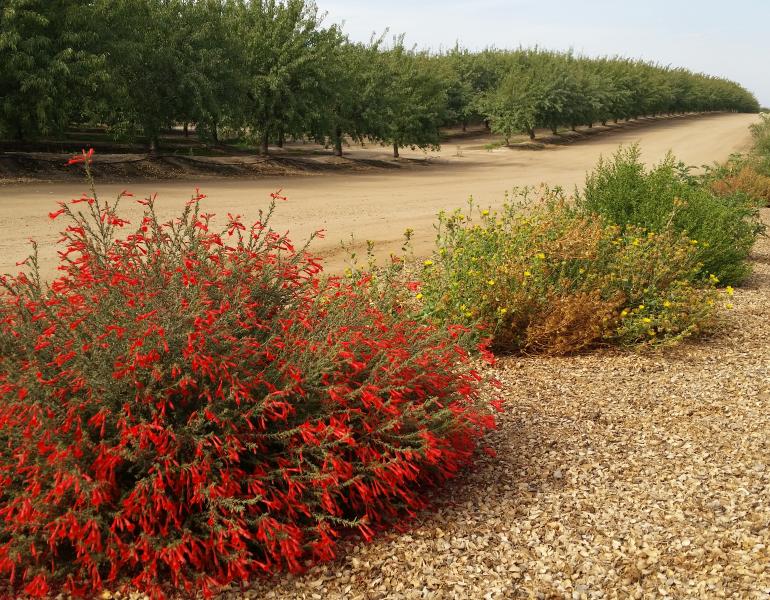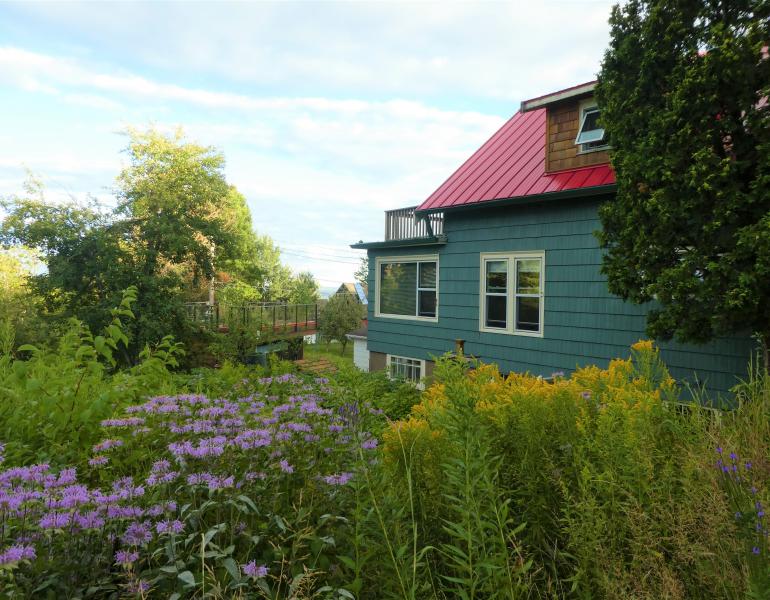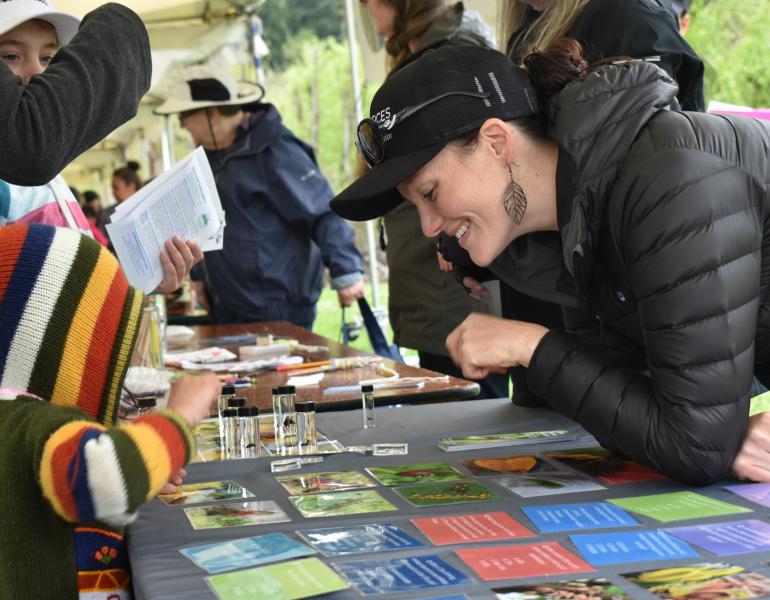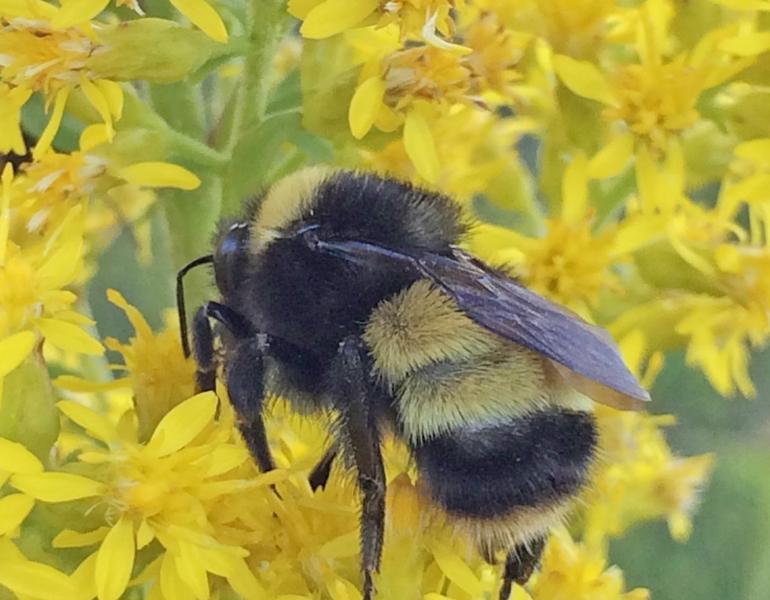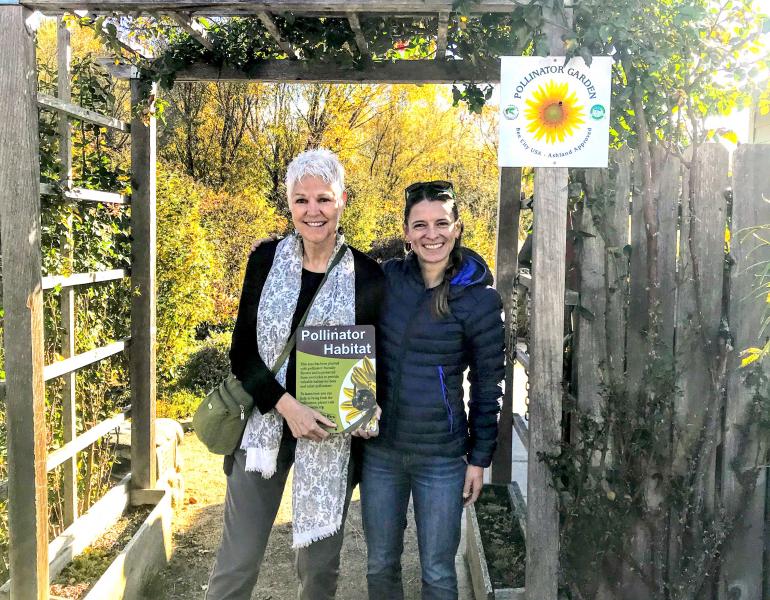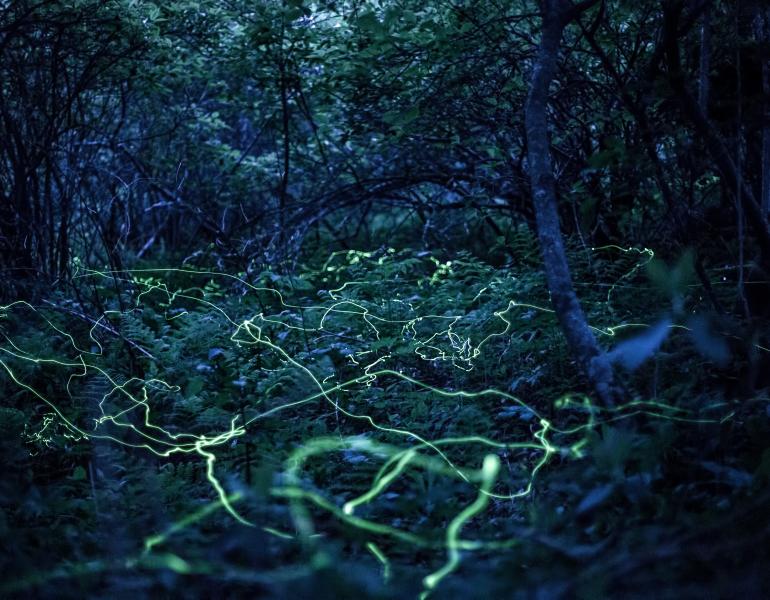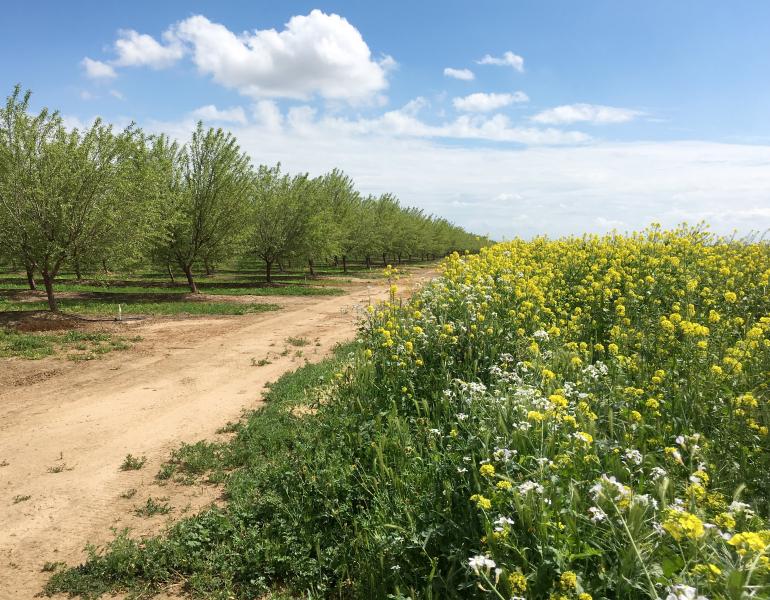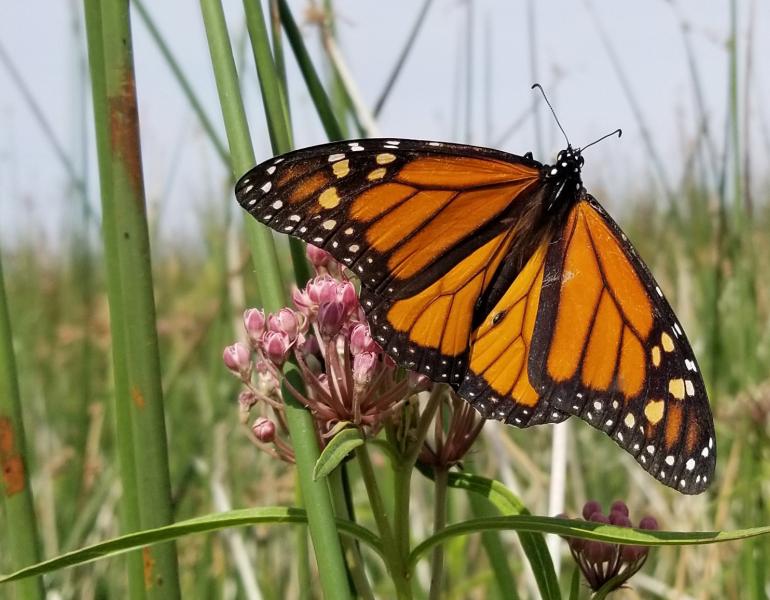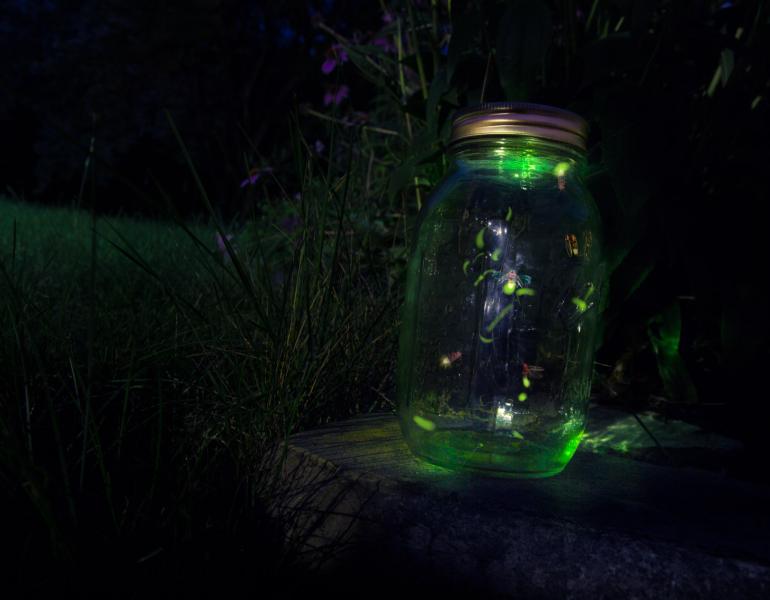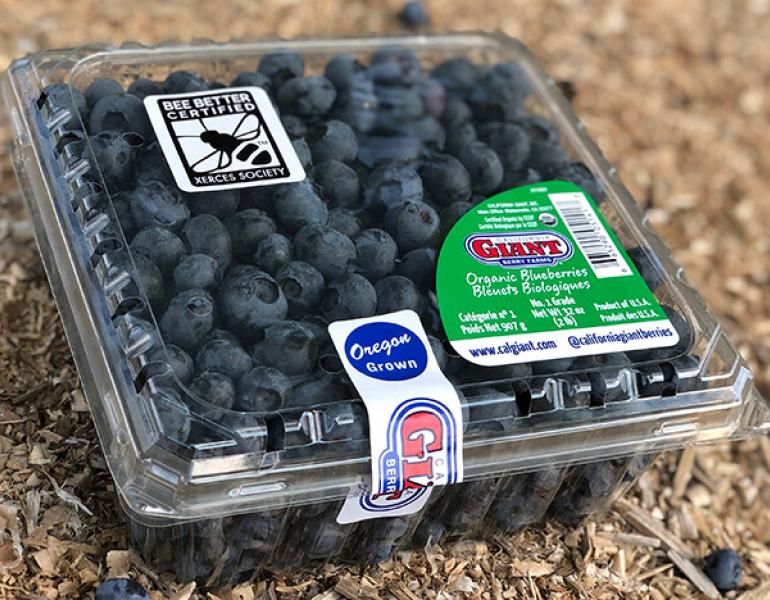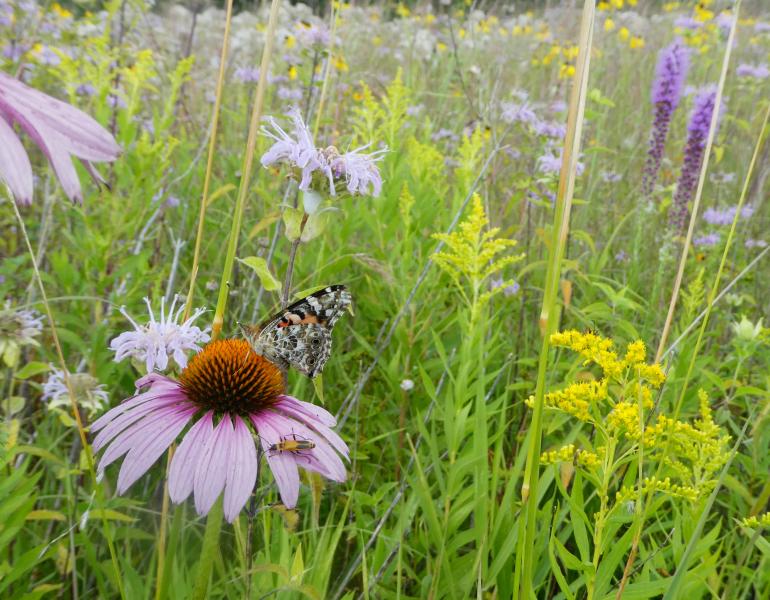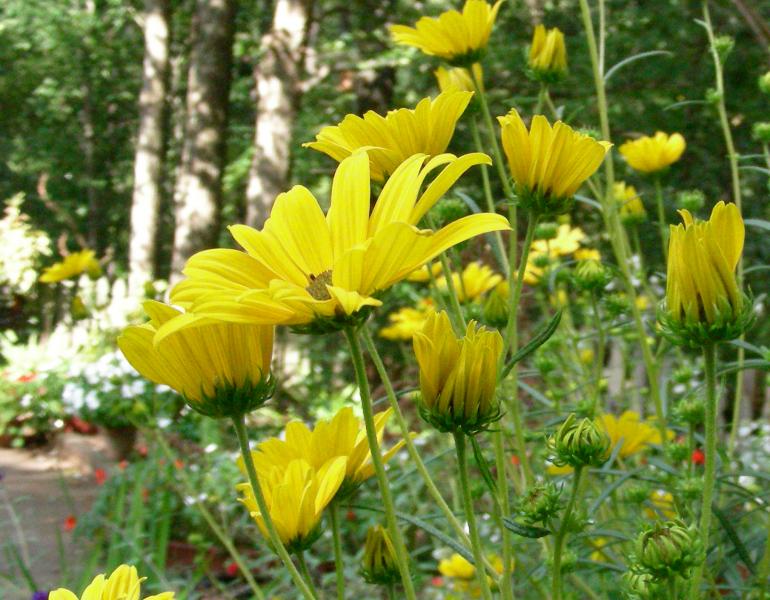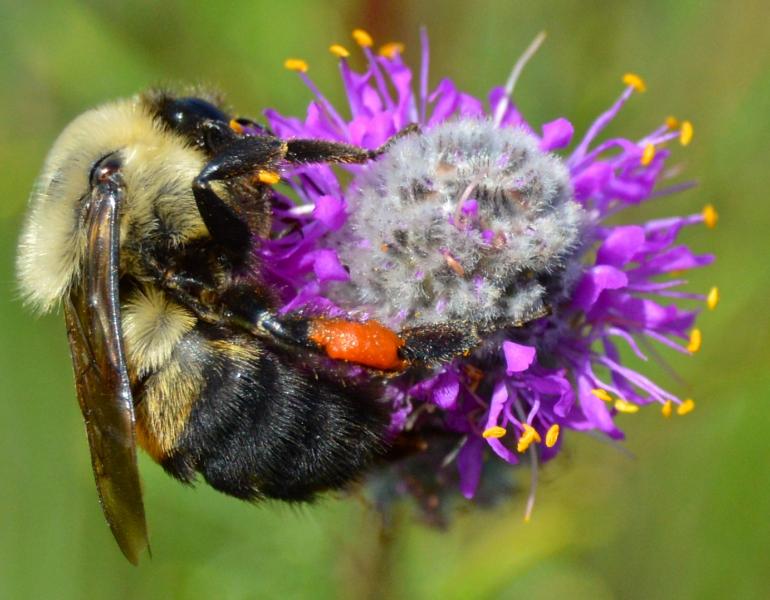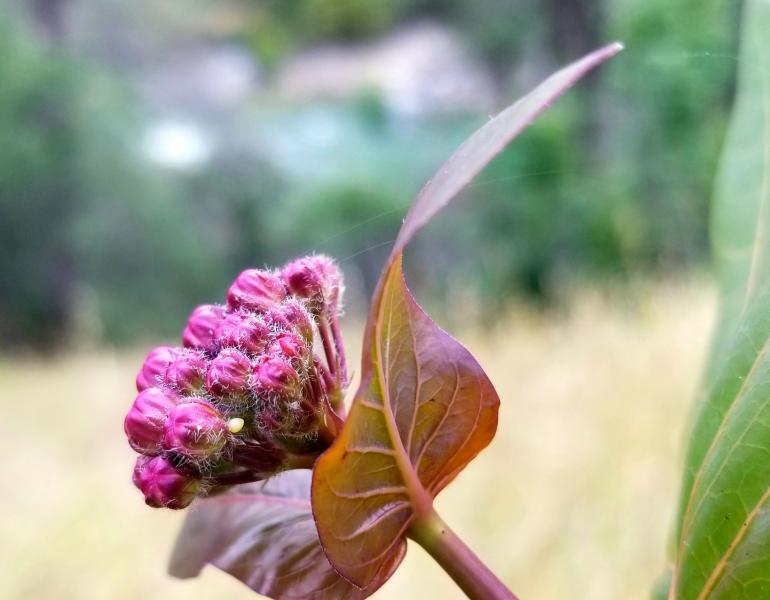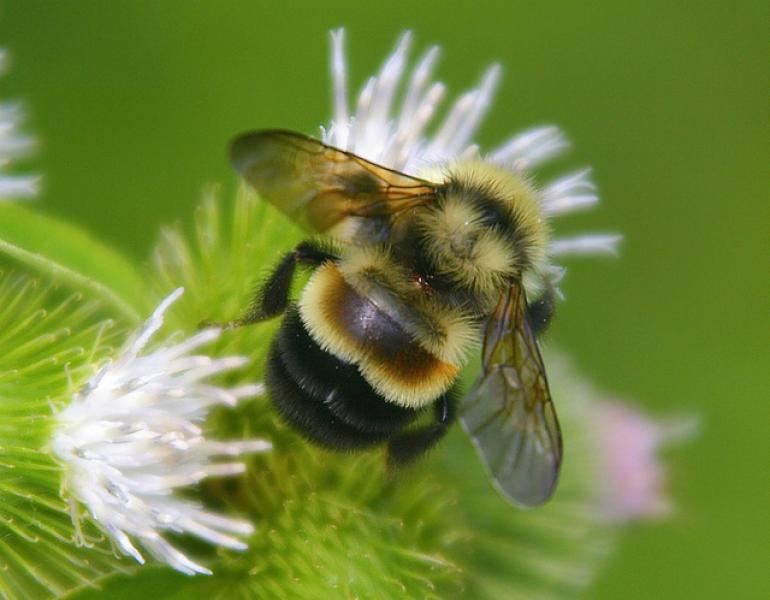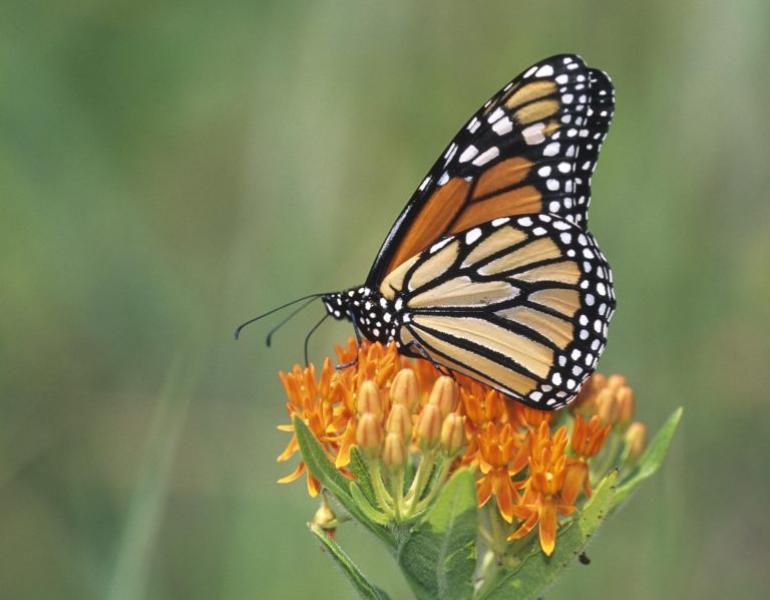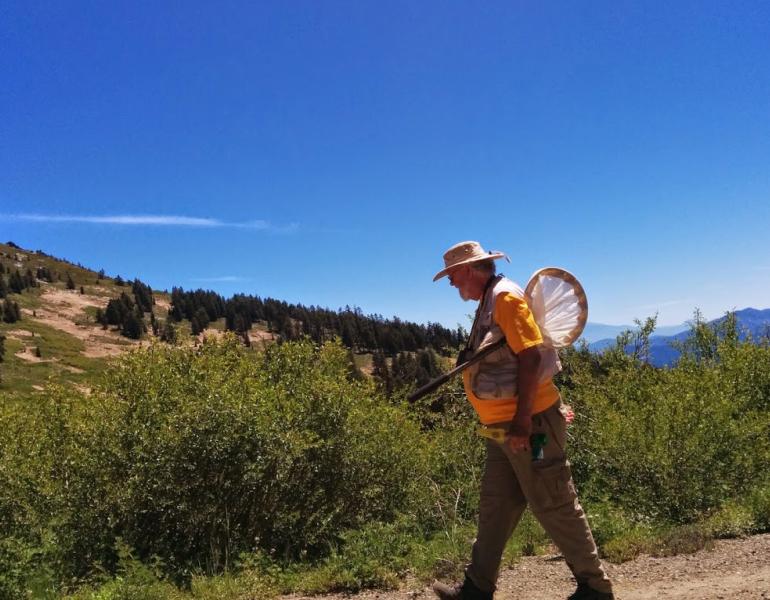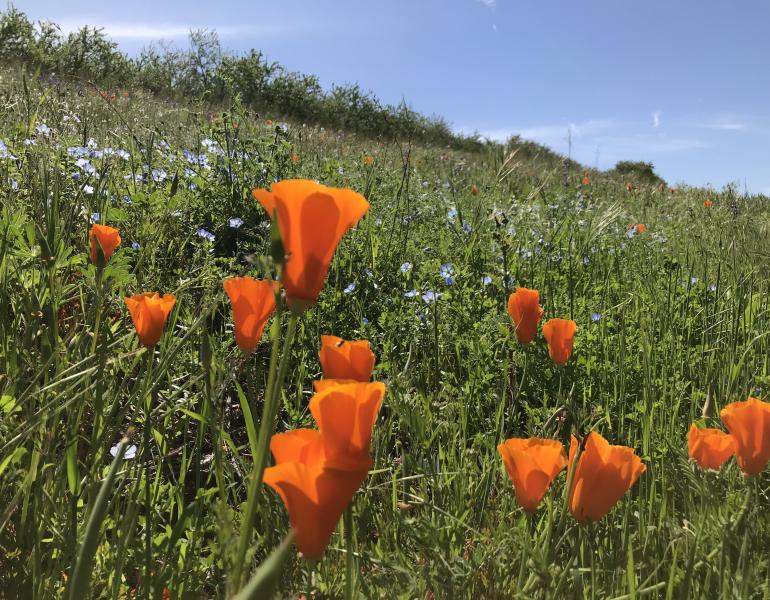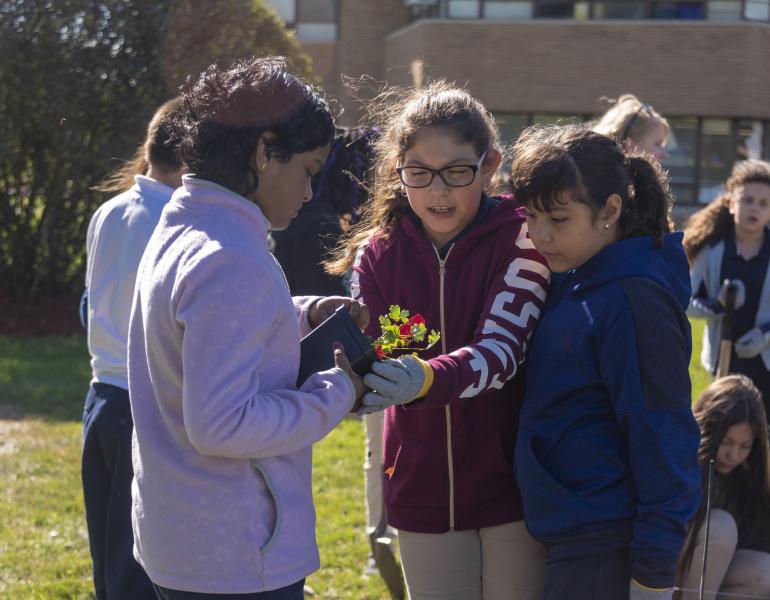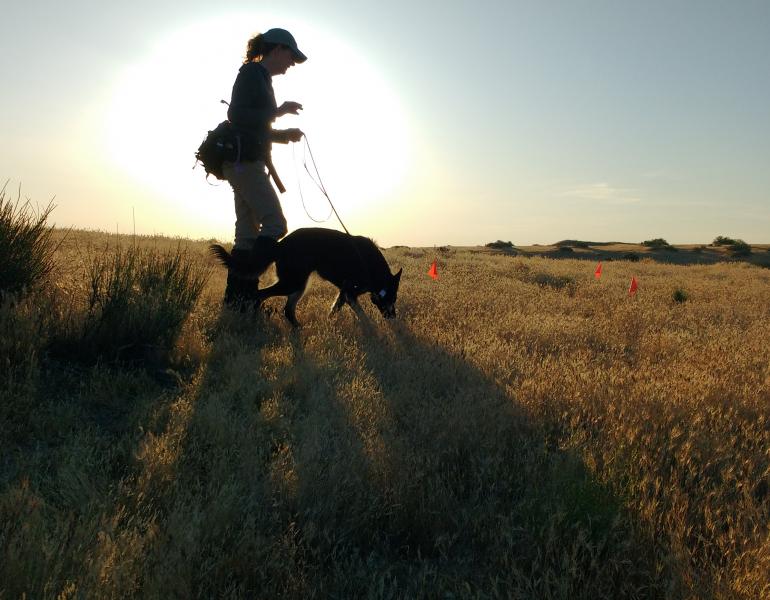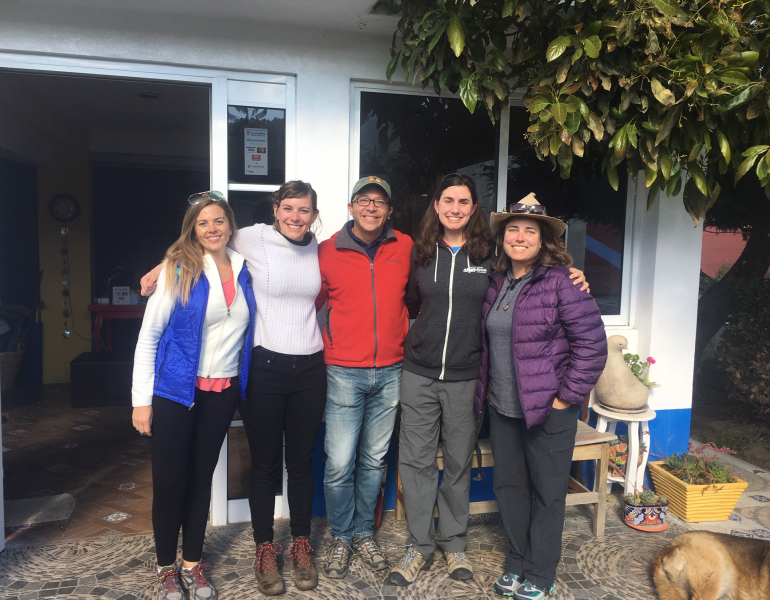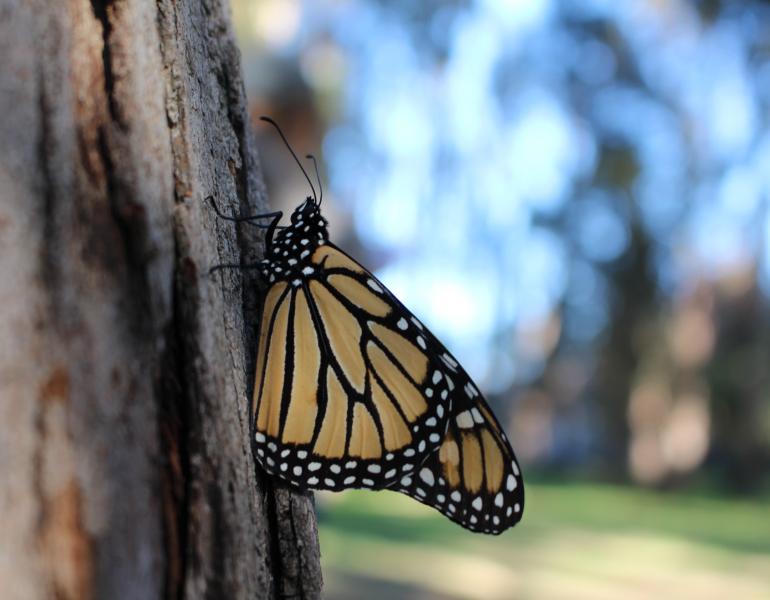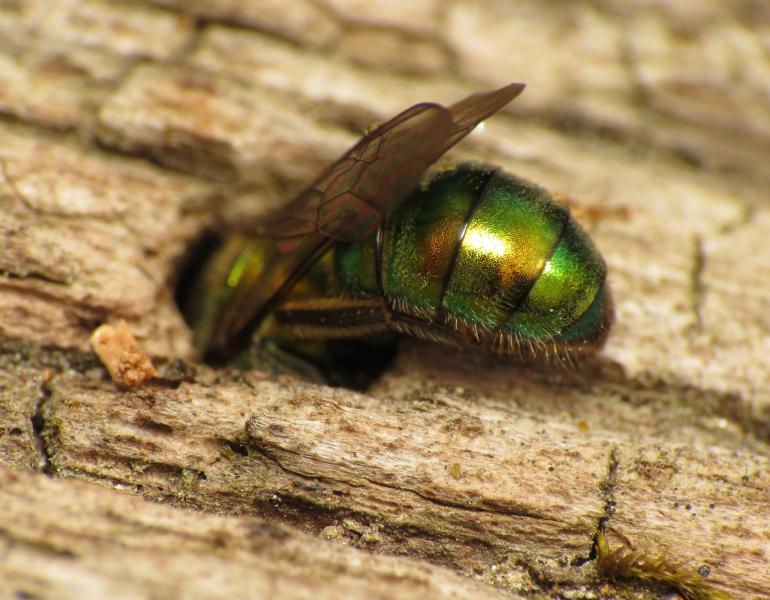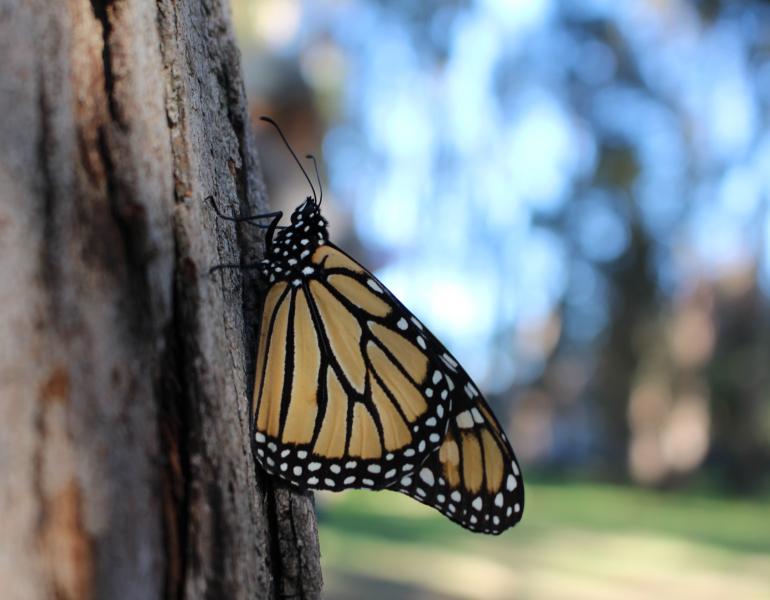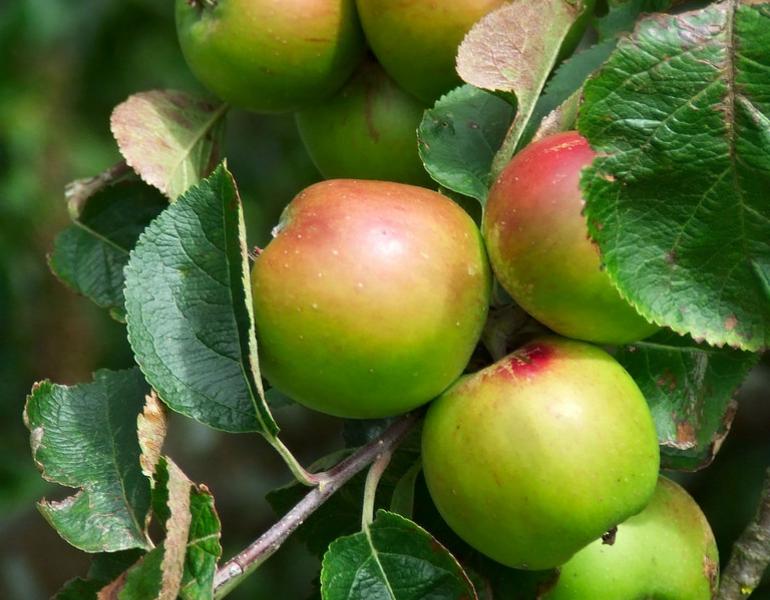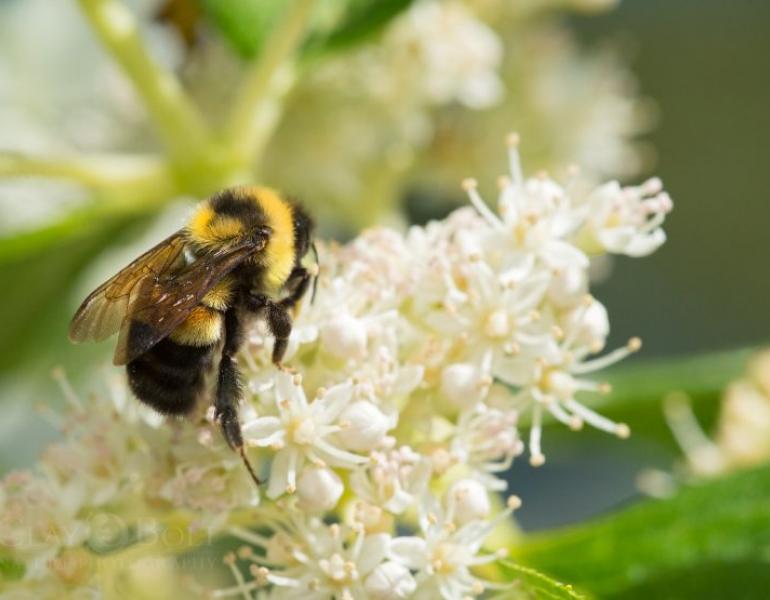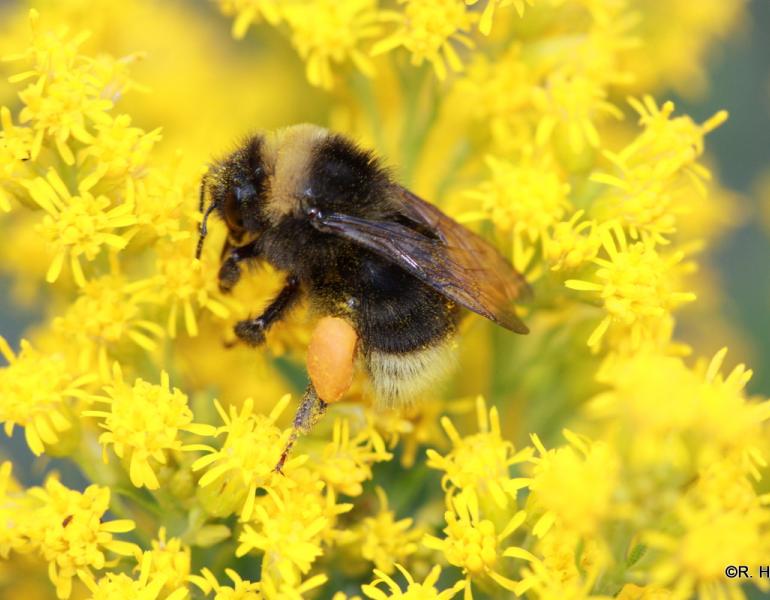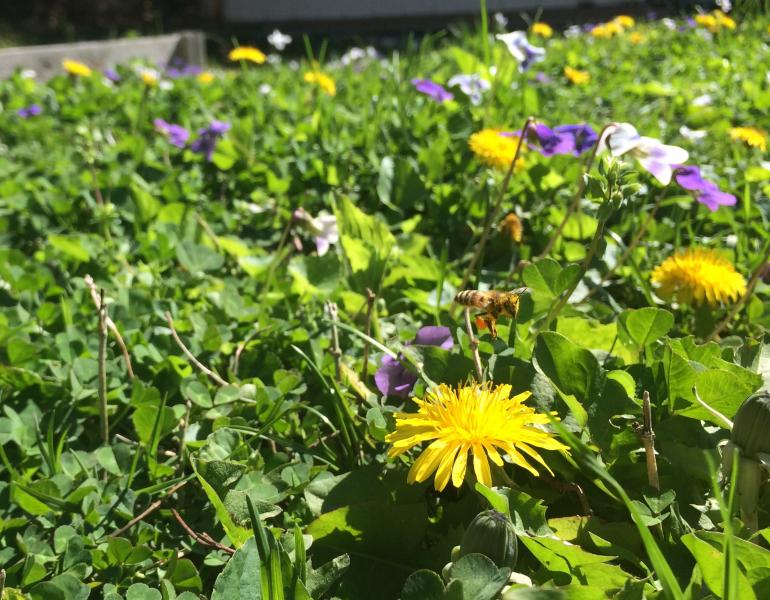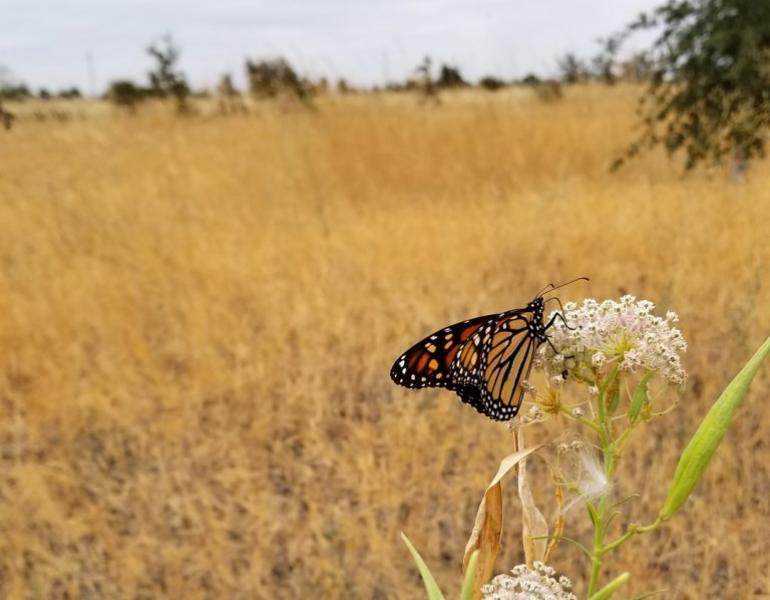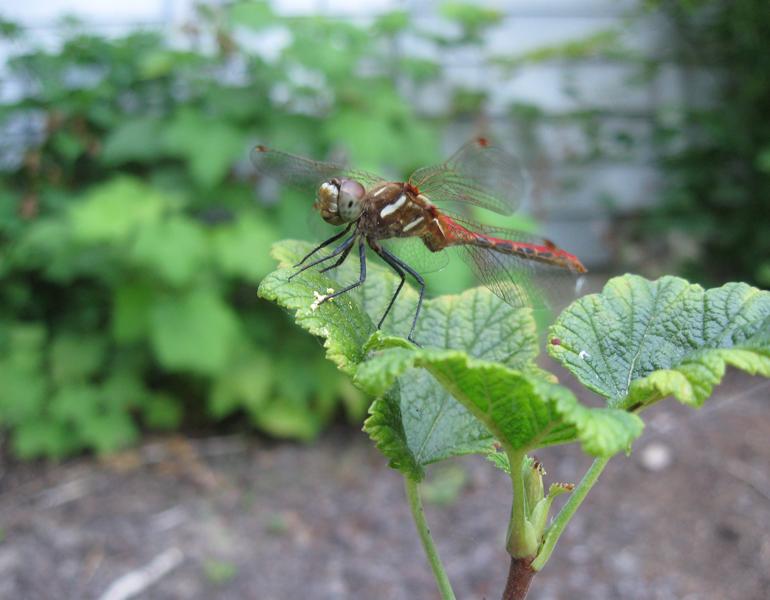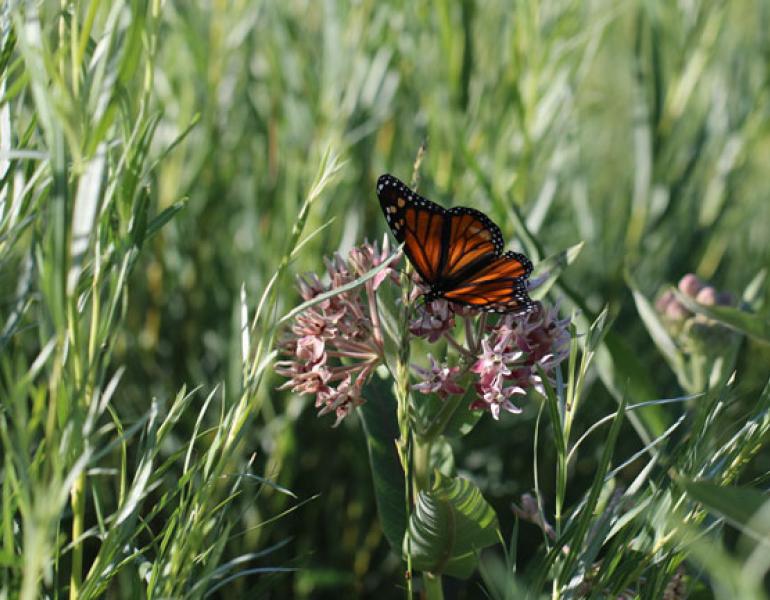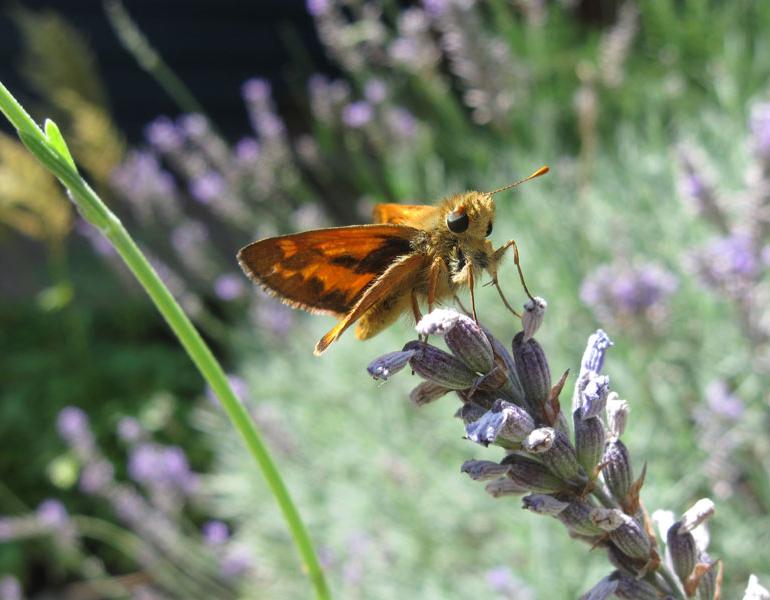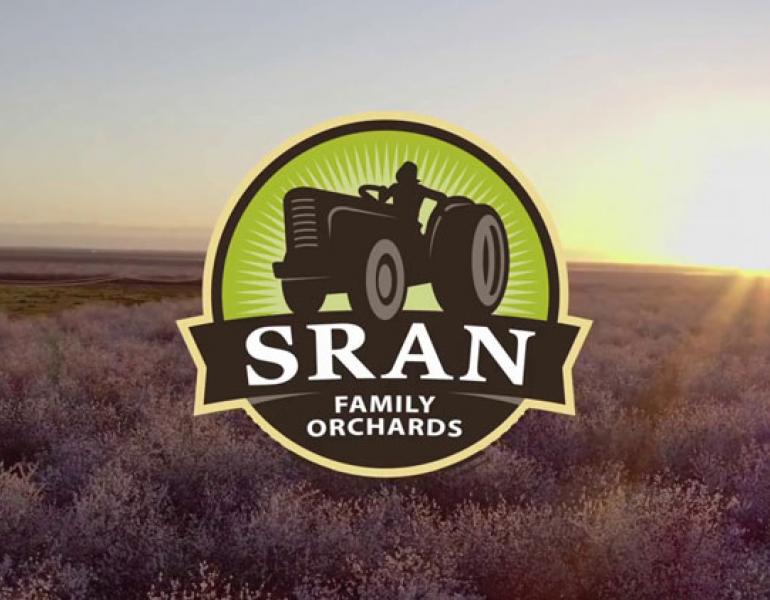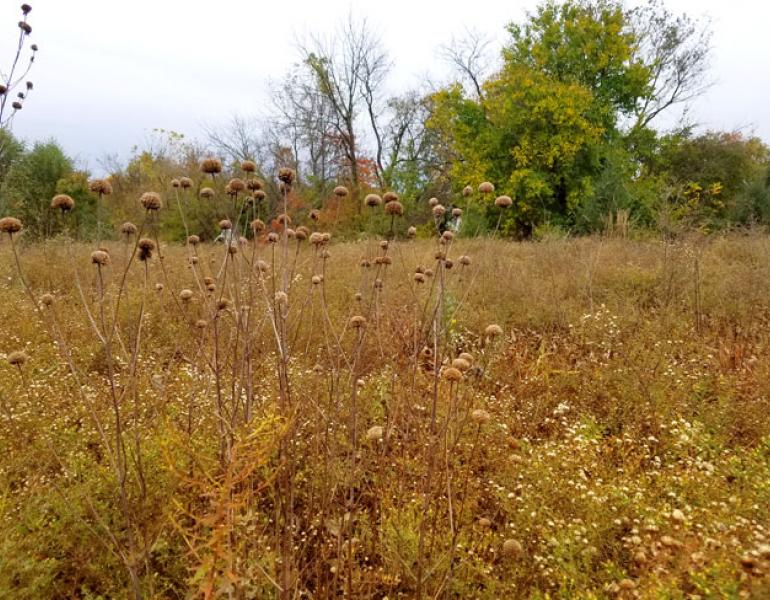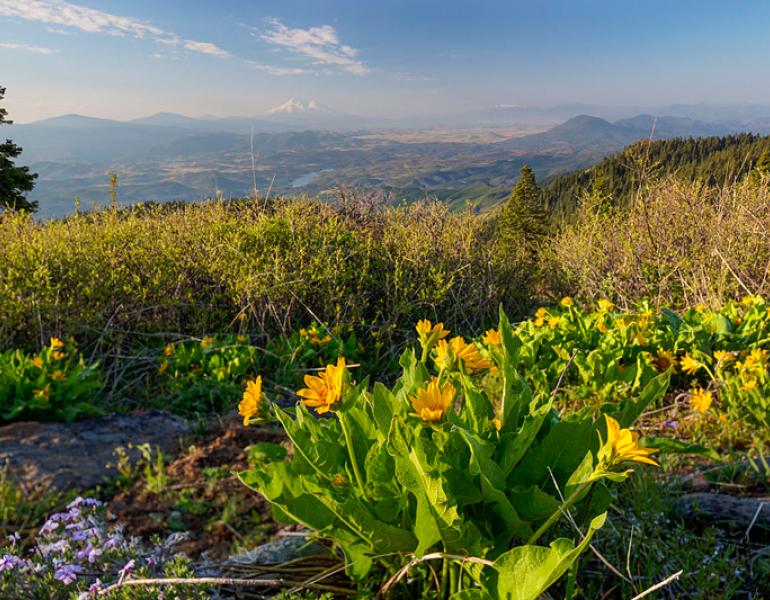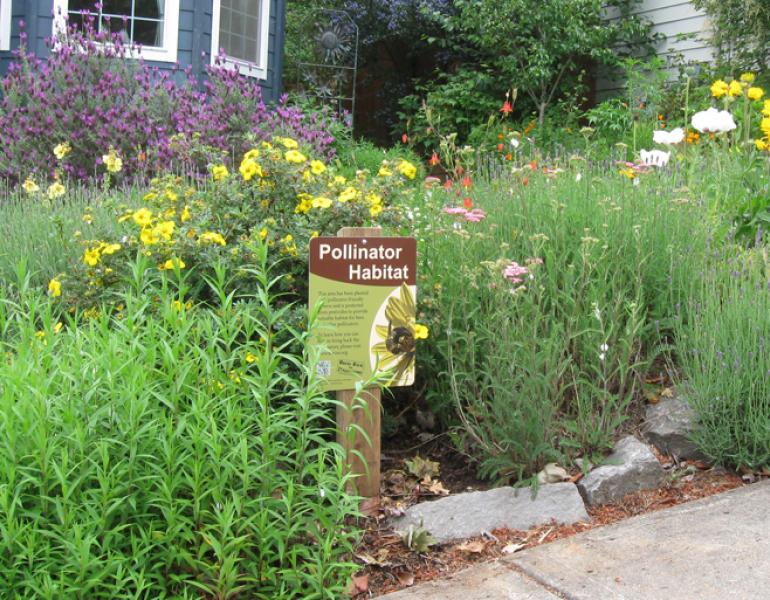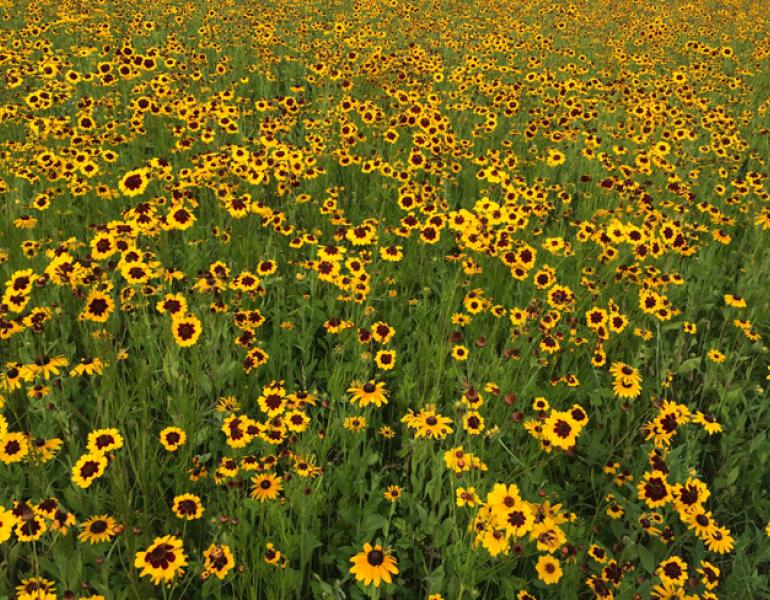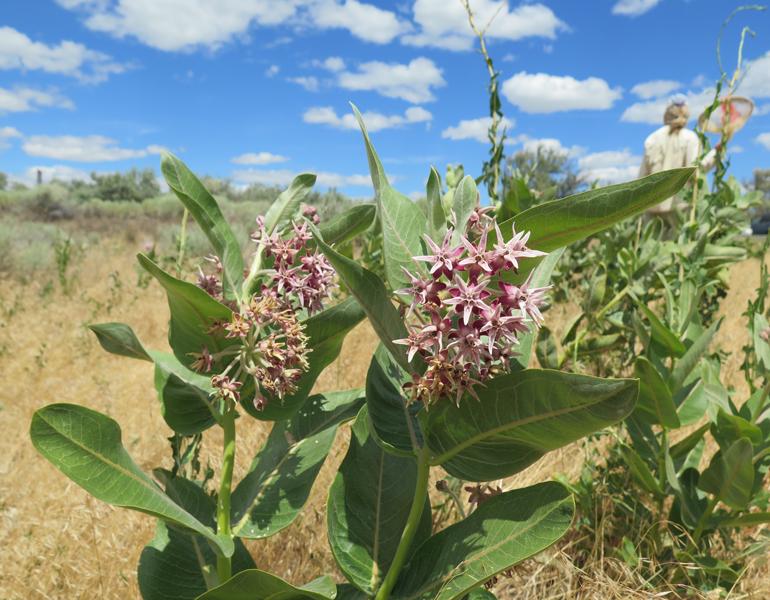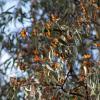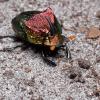Fallen leaves provide year-round habitat for all sorts of beneficial insects that eat pests in your yard!
How to Help
Leave the Leaves!
One of the most valuable ways to support pollinators and other invertebrates is to provide them with the shelter they need to survive the winter. Thankfully, all you need to do is do less yard work.
Keep Monarchs Wild: Why Captive Rearing Isn’t the Way to Help Monarchs
Instead of rearing—which is risky and unproven in helping monarchs—we should focus on more effective, science-backed ways to conserve these glorious wild animals.
Are Fireflies Going Extinct? Here Are Six Ways To Make Sure They Survive
Is this the last generation to see fireflies? We don’t think so. But we need to take action now to ensure they’re here to stay.
If You’re Thirsty, They’re Thirsty: Make a Simple Water Source To Support Pollinators
Even a humble puddle can make a big impact for your backyard wildlife. Learn how to make one that fits your space.
How to Make a Pollinator Garden
Gardens provide important food and shelter for pollinators. We've put together a list of tips that will help you prioritize the health and safety of these important garden inhabitants.
I See Dead Bees: What To Do Next and Why It Matters
Finding insects that have been harmed by pesticides is a sad experience. But there is a lot you can do to help prevent it from happening again!
Everything You Need to Know About Eastern Monarchs and How to Help Them
Monarch butterflies are famous for their colors and impressive migration. But they don’t all migrate in the same way! Discover what makes the eastern monarch population special.
No Mow May: An Easy Start for a Nature-Friendly Yard (But Not the Finish Line)
"No Mow May" is a quick and catchy name for a movement that aims far beyond not mowing the yard for a month. It's a gateway to understanding how we share our lawns with many small creatures.
Stronger Together: How To Build Your Conservation Community This Earth Week
Building your community can help us do more for conservation, and lightens the load and keeps us coming back to the causes we care about. Here's how!
For Pollinators' Sakes, Don’t Spring into Garden Cleanup Too Soon!
Early spring garden cleanup can disrupt critical invertebrate habitat and leave pollinators out in the cold. Our guidelines will help you determine when cleaning up won't bug the pollinators in your space.
New Year’s Resolutions That Will Benefit Nature, Wildlife, and Invertebrates
Start your year out right with a resolution that will make you feel inspired, empowered, and joyful! We’ve compiled a list of realistic and measurable new year’s resolution ideas that will benefit invertebrates, wildlife, nature, and you.
3 Ways to Host a Fundraiser for the Xerces Society
We’d love to have you join us in raising awareness and funds for the invertebrates that mean so much to all of us.
The EPA's New Strategies to Protect Endangered Species from Pesticides Need Improvement
The Environmental Protection Agency’s new rules represent progress toward reducing the risk of pesticides, but there are flaws in the plan that limit its effectiveness.
To Protect Pollinators, We Need to Fight Light Pollution
Just as water pollution makes every drink dangerous, light pollution puts nocturnal bugs at risk.
World Migratory Bird Day: Birds Need Bugs, And Both Need Our Help
Every action we take to save insects from pesticides, or to conserve nesting habitat for birds, helps the other. Together, bird watchers and bug fans can make a healthier world for everyone.
They Go with Everything: Even a Small Patch of Native Wildflowers Makes a Difference
Jennifer Hopwood shares how adding even a few plants is the perfect complement to the other habitat features of your yard, garden, or balcony.
Clear Space for Bees: Why Pollinators in Your Yard Need Access To Bare Ground
Open patches of soil and sand, with few or no plants, are a key nesting habitat for the majority of native bees, and easy for us to provide.
Wildlife on the Rocks: Providing the Rocky Habitats Bugs Need for Shelter
Rock piles and stone walls might seem like they take yard space away from plants, but these features are crucial to support a diverse wildlife community.
Tiny Places for Tiny Animals: Building the Microhabitats that Bugs Need to Thrive
It’s easy to add small features, like a brush pile, dead stems, or a leafy corner that can make a big difference for wildlife! Here's how.
The Power of Peer-to-Peer Fundraising: Join our December Fundraising Challenge!
We’re hosting a fundraising challenge this December, and we need your support! Prizes are available.
Protecting Invertebrates – Even When We Can’t See Them
Pesticides are a leading threat to fireflies and other insects. Fireflies' behavior, habitat, and life cycle make them particularly vulnerable to several common home pesticide applications.
These Bee-Safe Communities are Welcoming Back Pollinators
It takes a village to provide pollinator-safe spaces. These 8 communities are modeling the collaboration and creativity necessary to bring back declining pollinators.
Looking for Pollinator-Safe Plants? Talk to Your Nursery
Research suggests that even pollinator plants are often contaminated with pesticides at the store. Learn how to find plants that aren't and increase demand for pollinator-safe plants.
Top 7 Reasons to Stop Pesticide Use at Home
60 million pounds of pesticides are used in U.S. homes and gardens each year. Here are our top reasons to keep your space pesticide-free.
California Garden Center Leads by Example with Monarch Wishing Tree
Each spring a beautiful ficus tree transforms into something extra special for the folks that visit Roger’s Gardens plant nursery. The Monarch Wishing Tree displays hundreds of well wishes written on little wooden butterflies that support conservation.
Ways to Defend Biodiversity this Earth Week
Earth Week only comes once a year, so let's make it count! Defend biodiversity this week with one of these high-impact actions.
What is a Monarch’s Favorite Nectar Plant? Scientists are Seeking Your Observations
Xerces scientists are seeking your observations to learn more about adult monarch nectar plant preferences. Our revised system for this community science opportunity has made it easier than ever to submit data about monarch butterflies and the flowers they are nectaring from.
Can You Top These 15 Creative Xerces Fundraiser Ideas?
As it turns out, growing a beard can indeed support invertebrate conservation — with peer-to-peer fundraisers supporting the Xerces Society. Help us raise money and awareness while having fun and flexing your creativity. Use our ideas as inspiration and let your imagination shine!
Four Steps You can Take to Bring Back the Pollinators
Bees and other pollinators are clearly facing challenges from habitat loss and pesticide use, even climate change. By managing our gardens, parks, and other greenspaces with pollinators in mind, we can transform our towns and cities to support the insects that are essential for a healthy environment—and if we all do something, together we can have a big impact. Xerces' Bring Back the Pollinators campaign provides one way to achieve this change.
Businesses Support the “Little Things that Run the World”
Businesses are a vital part of achieving the necessary change to avert insect declines. We are lucky to work with dozens of them, from independent artists to some of the world’s largest food companies. No matter the size, we work with businesses that share our commitment to protecting biodiversity in all its forms.
Bee City USA & Bee Campus USA Affiliate Spotlight: University of Michigan-Dearborn
Pollinators are in decline, but what can a small or medium-sized university or college do to help? As it turns out, plenty. The University of Michigan-Dearborn has an outsized, long, and rich tradition of promoting environmental education and sustainability, especially in regards to pollinators—and in autumn 2019, was certified as a Bee Campus USA affiliate.
Using Community Science to Conserve Bumble Bees: From Small Beginnings to a Continent-Wide Effort
As we mark Xerces' 50th year, we look at the ongoing effort to protect bumble bees. Xerces has adopted a multi-pronged approach: outreach and education to raise awareness, technical assistance with habitat restoration, advocacy to gain legal protection, and, the focus of this article, community science to gather data that informs our work.
Building Resilient Communities: Reflecting on a Year of Challenge and Opportunity for Bee City USA & Bee Campus USA
The accomplishments of Bee City USA and Bee Campus USA communities during the last year are a textbook example of resilience. Rather than canceling projects and activities, the committees adapted to the new conditions, finding ways to continue creating spaces for our ecological communities to do the same.
What Should You Do for Pollinator Week? Go Bumble Bee Watching!
Going bumble bee watching is not only fun, but also a great way to contribute to real conservation science. Why not try it this summer?
Shedding Light on Firefly Natural History and Distributions through Community Science
Gathering habitat and distribution information about lesser-known species is a mammoth task, made easier by the observations submitted by individuals participating in community science projects. You can help, too!
Bee Better Certified: One Acre at a Time
When we launched Bee Better Certified® in 2017, our sights were set high on a large long-term goal: to move the agricultural industry towards being a safer landscape for bees and other pollinators. Large-scale change happens little by little over an extended period of time, and with each year that passes we continue to see increased interest and adoption of the program throughout the food industry.
Applying a Holistic Approach to Monarch Conservation
Xerces is a science-based conservation organization and our work on monarchs is no different. Whether it is restoring overwintering sites in California, creating breeding habitat in New York State, or protecting monarchs from pesticides, science informs our actions and maximizes our conservation return.
Supporting Firefly Conservation from Coast to Coast
Late spring and early summer are synonymous with fireflies. Females perch on vegetation or sit on the ground while males take flight, flashing their abdomens and awaiting a response from below. For humans, it could just as well be a magic show, a glimmering peek at one of the great wonders of the natural world.
Ask for a Healthier World
Do you want a more bee-friendly community or a different way to control mosquitoes? Change can start with a simple ask. Asking, if done respectfully and with curiosity, can bring empowerment and strengthen community.
The Actual Earth of Earth Week
Soils support the most biologically rich animal communities on earth, outside of our oceans. A single cubic foot of tallgrass prairie soil may contain billions of organisms, and more species diversity than the entire above-ground Amazon rainforest. Yet we think little of this life.
WARNING: this blog post may entice you to partake in “virtual democracy”
From the comfort of home, I engage in conservation efforts from Maine to California and from Tennessee to Washington. I can click “Join” knowing that no matter where that video link takes me, I’ll be met by dedicated people working to create a better world.
Pollinator Conservation Program Digest – March 2021
In our March 2021 Pollinator Team Digest, Alina Harris describes a community-based habitat project in New Hampshire to help monarch butterflies and other pollinators and Kaitlyn Haase shows the varied audiences and range of topics covered in recent webinars in the Southwest.
Resident Monarch Populations on the Rise in California: What Does this Mean for the Western Migratory Population?
Many people have been seeing and reporting fairly large numbers of monarchs, both adults and caterpillars, all winter long in gardens on the California Coast this year. Since there haven’t been any formal studies of the number of monarchs breeding during the winter in California in prior years, it is difficult to know if there is in fact an increase this year, or if people are paying more attention and reporting them more often.
Fifth Annual Western Monarch New Year’s Count Confirms Continued Decline in Western Monarch Population
Now in its fifth year, the New Year’s Count has given us a better understanding of: 1) how monarch numbers may decline at overwintering sites as the winter progresses; 2) how monarchs move between and within sites; 3) when they leave sites; and 4) the level of mortality that adult monarchs may be experiencing during the winter.
To Protect Pollinators, Talk to Your Nursery
Creating a welcoming home for local pollinators in your backyard or city park is reason enough to choose plants free from harmful pesticide residues. But how do you figure out if the plant you want is free of pesticides that can harm pollinators?
Pollinator Conservation Program Digest – February 2021
Our pollinator team members provide regular digests on their work. In this bumper edition, three of our staff provide updates. Stephanie Frischie discusses planting seeds, Nancy Lee Adamson highlights monarch conservation in the Southeast, and Emily May introduces a newly released video.
Western Monarch Population Closer to Extinction as the Wait Continues for Monarchs’ Protection Under the Endangered Species Act
During the 24th Western Monarch Thanksgiving Count, nearly 100 volunteers carefully surveyed groves of trees on the California and Northern Baja coast for monarch butterflies. Despite the challenges of conducting field work during a pandemic, volunteers surveyed 246 sites, three more than last year. Unfortunately, to the surprise and dismay of many, only 1,914 monarchs were counted at all the sites. This is a shocking 99.9% decline since the 1980s.
Leave the Leaves to Benefit Wildlife
For many people fall cleanup means cutting all the seed heads and stems off the flowers and raking up all of the leaves. This tidiness may look nice to us, but it is not good for all of the small creatures that live in and around your property. #leavetheleaves
Discovery of a Rare Plant Through Remnant Prairie Restoration
Less than one-tenth of a percent of Iowa's native tallgrass prairie remains. The scraps that survive are valuable refuges for less-common plants and deserve thoughtful management.
Hope Rising: World Firefly Day
World Firefly Day takes place from July 4–5 this year. Launched by the Fireflyers International Network, this year’s theme is Hope Rising. Quite literally, a light in the darkness, fireflies have inspired hope and given a sense of magic for centuries.
Notes from the Other Orders: Beetles as Pollinators
When we think about pollinators, the first species to pop into mind are usually bees, butterflies, and maybe, hummingbirds. But pollinators are a much broader group of animals that encompasses species from several groups of insects, including beetles such as like soldier beetles, scarabs, long-horned beetles, sap beetles, and checkered beetles.
Celebrating a Year of Enacting Positive Change: Bee City USA & Bee Campus USA
National Pollinator Week offers an opportunity to celebrate the importance of bees, butterflies, moths, flies, beetles, and the many other pollinators. It is also a time to celebrate the individuals and organizations that make up the affiliates of Bee City USA and Bee Campus USA for the amazing work they did during the last year to conserve our essential, and increasingly declining pollinators.
An Unlikely Invasion: Giant Hornets in North America
The giant hornet (Vespa mandarinia) has been in the media recently, where it was called the "murder hornet", an overly dramatic description for a generally unthreatening insect.
How to Maximize Benefits to Pollinators in Cities and Towns
Pollinators are one of the easiest groups of declining animals to support in a residential landscape, since even small spaces have the potential to meet the most basic needs of the entire insect life cycle—and even simple changes to our landscaping can make a huge difference to these animals. Here at the Xerces Society, we recently created an Urban Habitat Assessment tool, designed to help you see your yard through the eyes of a pollinator, identify areas for improvement, and prioritize actions you can take to promote these insects in your yard and community.
Start Now To Prevent Mosquito-Borne Disease and Keep Our Pollinators Safe
The Xerces Society’s new fact sheet, Smarter Pest Management: Responding to Mosquito-Borne Disease and Protecting Pollinators, highlights ways for everyone to prevent mosquito-borne disease, with recommendations that are backed by the Centers for Disease Control and Prevention (CDC).
Tracking Butterfly Populations through Community Science
Last year, the Xerces Society partnered with the Cascade-Siskiyou National Monument to launchthe Cascade-Siskiyou Butterfly Monitoring Network. Though the 2020 field season is facing uncertainty, there are still ways for you to get involved with butterfly research where you live.
Nebraska Bumble Bee Atlas: Doing a Little to Impact the Whole
The 2020 survey season begins this June. We hope you’ll join us in our quest to learn more about bumble bees and restore Nebraska’s natural habitats.
This Earth Week, Let's Bring Communities Together to Protect Pollinators
Bee City USA provides a framework for communities to work together to conserve native pollinators by providing them with healthy habitat, rich in a variety of native plants, and free to nearly free of pesticides.
Earth Week Reading: Gardening to Save the Planet
Rich Hatfield, Senior Endangered Species Conservation Biologist, writes in this book review, "I was expecting The Garden Jungle: or Gardening to Save the Planet to be a great read, but for me it was more than that."
12 Climate Actions for Earth Week
Some good news (amidst all the bad lately) is that even with physical distancing and shelter-in-place requirements, there are still a lot of actions many of us can take to help in the fight against climate change. Focusing on one or any combination of these actions can help.
The Xerces Society's Response to COVID-19
The science is clear: We all need to take immediate, bold action to ensure that we are doing our part to slow the spread of this virus and minimize impacts. Here are some of the steps Xerces is taking.
Monarchs Overwintering in Mexico Down 53%
This decline makes it clear that monarchs are not recovering and still urgently need Endangered Species Act protection in the United States and extraordinary conservation efforts throughout North America. Learn how to help here.
Five Ways to Support Queen Bumble Bees this Spring
This is a critical time of year because the queen needs sufficient food herself, as well as enough to nourish her first batch of developing offspring. Adding early blooming shrubs and trees to your yard or garden can provide essential resources that will help springboard the colony to health.
New Year’s Count Finds Continued Decline of Monarchs Overwintering in California
Monitoring revealed an average decrease of 46% between the Thanksgiving and New Year’s counts. While the decline is alarming, the silver lining is that this data has provided a concrete list of priority sites to target for conservation efforts.
Evolution in Attitudes Leads to Greater Interest in Pollinator Conservation
Twenty years ago, being referred to as the “bee guy” wasn’t always positive. In contrast, today many people are keen to learn about what they can do to protect pollinators. We are proud to be part of the reason that the public has become more aware of, and engaged in, pollinator conservation.
Support Pollinator Conservation by Reducing or Eliminating Pesticide Use in Urban Environments
Our new fact sheet, Smarter Pest Management: Pollinator Protection for Cities and Campuses, outlines key steps to reduce or eliminate pesticide use in municipal parks, campuses, and other urban greenspaces.
Tu BiShvat, the New Year for Trees, Provides a Chance to Support Invertebrates
This ancient tradition fits into modern life—and invertebrate conservation efforts—perfectly. Modern festivities frequently focus on planting ecologically important trees and shrubs—such as pollinator-friendly or butterfly and moth host plants.
The Vanishing Butterfly Groves of California
The latest research suggests that the damage and loss of overwintering habitat is one of the primary drivers of the decline of western monarchs. Together, we can make overwintering site protection and management a reality.
Thanksgiving Count Shows Western Monarchs Need Our Help More than Ever
The western monarch population remains at a critical level. With some luck and a lot of hard work, we have hope that we can save this incredible migration.
Xerces' Holistic Approach to Conservation
We at the Xerces Society view our work as an interconnected whole rather than as separate parts. To achieve conservation success, we must understand both science and policy. We need to inspire people and at the same time empower them with the tools they require.
Climate News Roundup: IPCC Lands Report
When most people think about climate change, they likely think of CO2 emissions from cars or factories. But the way land is used and managed has a significant impact on the climate.
Insect Apocalypse? What Is Really Happening; Why it Matters; and How We All Can Help
Studies from across the world show that insects are declining. There is much we do not know, but we do know enough to take action now.
Hope and Heart: Engaging Volunteers in Conservation
Rachel Dunham, Xerces Society Community Engagement Coordinator, reflects on the pilot year of l Xerces Ambassador program and looks ahead to the program's expansion to new cities.
Still Questing for Bee Nests
Did you beat the odds this year and spot a bumble bee nest? If so, we really want to hear from you for York University’s #Quest4BeeNests research project!
Bee City USA Begins a New Chapter
We're celebrating the achievements of Bee City USA founder Phyllis Stiles as she moves on to a well-deserved retirement and passes the torch to Bee City USA Coordinator Molly Martin.
Conserving the Jewels of the Night
Introducing the Xerces Society’s firefly conservation campaign: Conserving the Jewels of the Night.
Pollinator Conservation Program Digest – October 2019
October's featured staff members recently attended a carbon farm planning training in California, and spoke at an event that paired art and conservation in Iowa.
Western Monarchs: Notes from the Field
Staff from the Xerces Society and our partners have been keeping close eyes on the imperiled western monarch population at study sites in California, Nevada, Oregon, Washington, and Idaho as part of a multi-year collaborative research project.
Nature Close to Home: Reimagining Gardens to Support Invertebrates
Scott Hoffman Black, executive director of the Xerces Society, encourages gardeners to increase the diversity of native plants, ensure that there are places for insects to nest, and avoid using pesticides.
Climate News Round-Up: The Power of Trees!
Carbon sequestration is a key component to mitigating the climate crisis. Trees are efficient, effective, and they can be deployed on a large scale. So plant a native tree today!
Community Science Powers New Western Monarch Studies
Western monarch researchers and community scientists have been busy, contributing information vital to understanding the situation facing this imperiled population.
Arriving in Stores: Bee Better Certified Blueberries
In partnership with AC Foods and Oregon Tilth, we’re pleased to announce the arrival of California Giant brand Bee Better Certified organic blueberries.
Celebrate World Firefly Day by Keeping Nights Dark
Fireflies are some of our most well-loved insects—yet their numbers appear to be dwindling. One likely driver for this decline is light pollution. Put simply, fireflies need dark nights.
Let’s Make Every Week Pollinator Week!
Without a doubt, every week is Pollinator Week here at the Xerces Society. Here are a variety of ways to support our efforts to conserve these vital invertebrates throughout the year—no matter where you live!
Working to Conserve Monarchs from Coast to Coast
The Xerces Society is working across the U.S. to conserve this beloved species, and there are a number of ways you can help!
Remember the Ground Nesting Bees when You Make Your Patch of Land Pollinator-Friendly
Providing nesting sites and reducing or eliminating pesticide use is key to supporting these important pollinators.
Managing Invertebrate-Friendly Gardens
Many Xerces Society members create wildlife gardens that are particularly hospitable to invertebrates. Here are three wonderful examples.
Introducing Xerces’ Newest Community Science Project: Nebraska Bumble Bee Atlas
Work alongside researchers to collect data and support bumble bee conservation.
Bee City USA: Galvanizing Communities to Reverse Pollinator Decline
Collectively, urban and suburban areas have the potential of offering millions of acres of life-giving habitat to pollinators.
Bring Back the Pollinators During National Pollinator Week
With Pollinator Week upon us, now is the time to reaffirm our commitment to protecting these vital invertebrates. Here are some tangible ways to help.
New iNaturalist Project Makes it Easier to Submit Data to the Western Monarch Milkweed Mapper
We need all hands on deck this season, to better understand the hurdles facing the imperiled western monarch population!
5 Ways Wildlife Preservation Canada’s Bumble Bee Recovery & Conservation Initiatives Benefit from Bumble Bee Watch
Wildlife Preservation Canada’s efforts to conserve native bumble bees would be nothing without help from our volunteer community scientists across the country, and without Bumble Bee Watch.
How to Support Monarch Butterfly Conservation—During Earth Week and Beyond!
Helping the monarch back to full health isn’t going to be easy or quick, but together we can transform the landscape to allow the monarch to rebound—and give our children the gift of watching orange wings flap in the sunshine.
Bee City USA Mobilizes Communities to Support Imperiled Pollinators—Here’s How to Join
Earth Week is an inspiring time, brimming with opportunities to make a difference—including getting your community certified as a Bee City USA.
Honoring Robbin Thorp, a Legendary Figure in North American Bee Conservation
Robbin Thorp, Professor Emeritus at University of California–Davis, has made lasting contributions to the bee conservation community in ways that might never be measured, but will certainly be felt.
Pesticide-Free Gardening Tips for Earth Week and Beyond
Please consider spending Earth Week in the garden, enjoying the diversity of insects, and taking a few of the actions outlined below to simultaneously minimize pest problems and avoid the use of pesticides.
Bee Better Certified Engages the Almond Industry
With a robust set of requirements on pesticide use and the highest standards for protecting and restoring pollinator habitat of any food certification, Bee Better Certified represents a new era in biodiversity protection on farms.
Pledge to Bring Back the Pollinators—on Earth Day and Every Day
During Earth Week 2019, we are asking you to consider taking simple, yet impactful, steps to make the world better for bees, butterflies, and other essential invertebrates.
Community Scientists Take on the Cultivar Conundrum
The Xerces Society’s blog post “Picking Plants for Pollinators: The Cultivar Conundrum” highlighted the lack of research on this topic. To help address this knowledge gap, Budburst launched the Nativars research project in 2018.
A Quest for Bumble Bee Nests: The Missing Link
Researchers at York University are recruiting members from across North America for a very important mission. Your assignment, should you choose to accept it: find and submit sightings of bumble bee nests.
Bee Better Certified: An Evolving Standard
After a year and a half of Bee Better Certified®, we have analyzed how the standards work for the many operations that are already implementing them, and have adjusted our requirements accordingly.
Community Scientists Can Help Support Imperiled Western Monarchs
While hiking in California and the rest of the West, you can help researchers by submitting any and all monarch and milkweed observations this year to the Western Monarch Milkweed Mapper website.
Photo Essay: Trinational Monarch Meeting and Exploring Mexico’s Monarch Overwintering Sites
Xerces Society Endangered Species Conservation Biologist and Western Monarch Lead Emma Pelton recounts her recent experience in Mexico with this photo essay.
Record Low Number of Overwintering Monarch Butterflies in California—They Need Your Help!
We urge you to join us and our colleagues in the western monarch science and conservation community in taking meaningful, swift action to help save western monarchs.
Climate News Round-Up: January 2019
Climate change is an unprecedented global challenge. Angela Laws, our resident climate change expert, reviews recent news on the topic and provides concrete ways to help.
Businesses Aligning with the Life that Sustains Us
The trend of business owners aligning with social and environmental causes is on the rise. Here at the Xerces Society, we are feeling these benefits—and are very thankful for the support.
Where Do Pollinators Go in the Winter?
Most native bee species will spend the winter in the nests that their mothers provisioned. In fact, just like bears, many pollinators hibernate through the winter—and they may need a little help to survive until spring.
Early Thanksgiving Counts Show a Critically Low Monarch Population in California
The California overwintering population has been reduced to less than 0.5% of its historical size, and has declined by 86% compared to 2017.
Celebrate Invertebrates During National Apple Month
No matter how you obtain your apples—whether you pick them yourself, grab them at the grocery store, or go bobbing for them—it is important to take a moment to remember the pollinators and beneficial insects that make this delicious harvest possible.
The Endangered Species Act Needs Your Help!
The Endangered Species Act is our nation’s most effective law for protecting animals and plants in danger of extinction, and it has prevented 99% of listed species from going extinct. We need your voice to help defend this crucial law.
Xerces Society + Bee City USA = A Match Made in Pollinator Heaven
Bee City USA brings a unique approach that encourages cities and college campuses across the United States to develop and implement a plan for helping pollinators.
Surprising Results from a Survey of Bumble Bee Watch Users
This past February, Bumble Bee Watch users were invited to take a survey run by York University researchers to learn more about participant demographics, motives, and confidence with bumble bee identification.
Bee Friendlier with Your Lawncare
If you’re ready to re-think your lawn, read on for practical advice and small changes that can help support pollinators and a healthier planet.
Managing for Monarchs in the West
A new guide to protecting the monarch butterfly from the Pacific to the Rockies presents a holistic approach to monarch conservation.
10 Ways to Celebrate Earth Day
Here are some ways you can work to promote a healthy planet for invertebrates and the people they let share their planet.
How Our Gardening Choices Affect the Health of Our Waterways
Pesticide Program Director Aimee Code shares thoughts on her garden, information about pesticide impacts to our watershed, and news about upcoming Xerces projects in this article from Wings Magazine.
Very Low Numbers of Monarchs Overwintering in California may Reflect an Unusual Fall
Unusual fall weather may have contributed to the lowest overwintering western monarch population recorded since 2012.
Staff Stories: Life in the Suburbs
Our Communications Director Matthew Shepherd shares stories of creating a mini wildlife sanctuary in his Portland, OR garden, and the many plant/insect interactions that have brought his family so much enjoyment in a suburban space.
Sran Family Orchards: The First Bee Better Certified Farm
Sran Family Orchards, the world’s largest grower of organic almonds, has long committed to sustainable farming, with flower-rich pollinator habitat as an integral part of the almond orchards. This investment recently paid off when Sran Family Orchards gained certification as a Bee Better Certified grower.
Picking Plants for Pollinators: The Cultivar Conundrum
What are cultivars, and do they have the same benefits to pollinators as non-cultivars? The answer depends—not all cultivars are created equally.
Planning Your Plantings for Climate Resiliency
With earlier springs and warmer fall days - pollinators need plants that provide resources at the farthest fringes of the growing season.
Going Beyond the Bloom: Don’t Be Just A Flower-Weather Friend
There's still plenty to do to restore, protect, and expand habitat in the "off" season!
Telluride Teen Takes Action Helping Pollinators
In Telluride, Colo., Soleil Gaylord has been growing and sharing seeds since grade school, initiated a habitat revegetation project, and more recently, organized an art show in support of pollinators. This is her story, in her own words.
To Protect Moths—Turn Out the Lights!
Happy Moth Week! National Moth Week is the last full week in July and is a time to get outside—day or night—and appreciate these less-celebrated Lepidopterans.
Don’t Downsize the Cascade-Siskiyou National Monument
The Cascade-Siskiyou National Monument is unique among the BLM’s National Conservation Lands in that it is one of the most biologically diverse places in North America.
Protecting Pollinators One Community at a Time
Pollinators need habitat that is protected from pesticides. Learn how you can encourage your local government to adopt policies that protect pollinators.
Are you up for the Million Pollinator Garden Challenge?
Can the nation establish a network of one million pollinator gardens within two years? Yes we can!
Science: Something Worth Marching For
Science underpins all that we do. That's why we're proud to be partners in the 2017 March for Science.
To Save Monarchs, We Need More than Just Milkweed
Adult monarchs need nectar to fuel them during spring migration and breeding and to build up stores of fat which sustain them during fall migration and winter.
Monarch & Milkweed Workshops Engage Public Land Managers in Western States
These trainings are part of a partnership to increase the number of biologists, land managers, and agency staff working towards western monarch conservation.
ID Dragonflies and Locate Hotspots with the Dragonfly ID App!
Calling all nature enthusiasts! Do you have a smartphone and want to use it to explore, identify, and marvel at the diversity of dragonfly and damselfly fauna in your backyard, local wetland, or favorite trout stream? Well, now you can!
Wildflowers, Harbingers of Spring
Spring wildflowers are an important first food of the season for pollinators. Jennifer Hopwood discusses the importance of these harbingers of spring.


